Notes on Confinement on R3 × S1: From Yang–Mills, Super-Yang–Mills, and QCD (adj) to QCD(F)
Abstract
:| Contents | ||
| 1. | Introduction.......................................................................................................................................................................................................................................................... | 2 |
| 1.1. What Are These Lectures About?........................................................................................................................................................................................................... | 3 | |
| 1.2. Why Study Small-L Theories? In Lieu of Conclusion........................................................................................................................................................................... | 5 | |
| 1.3. Philosophy and a Reader’s Guide........................................................................................................................................................................................................... | 6 | |
| 2. | Flashback to the 1970s: Polyakov Confinement on R3................................................................................................................................................................................... | 7 |
| 2.1. Perturbative Analysis of the IR Theory.................................................................................................................................................................................................. | 8 | |
| 2.2. Finite Action Monopole–Instantons in the Polyakov Model............................................................................................................................................................... | 9 | |
| 2.3. Monopole–Instantons and the IR: I. First Pass...................................................................................................................................................................................... | 13 | |
| 2.4 Monopole–Instantons and the IR: II. Duality, ’t Hooft Vertices, and Monopole Operators............................................................................................................. | 15 | |
| 2.5. Monopole–Instantons and the IR: III. Dilute Gas and Mass Gap........................................................................................................................................................ | 21 | |
| 2.6. Monopole–Instantons and the IR: IV. Confinement and the String Tension..................................................................................................................................... | 24 | |
| 3. | From R3 to R3 × S1: Generalities....................................................................................................................................................................................................................... | 31 |
| 3.1. Holonomy, Polyakov Loop, Center Symmetry, and the Weyl Chamber........................................................................................................................................... | 31 | |
| 3.2. Spectrum near Center Symmetry. When Does Small-L Imply Weak Coupling?.............................................................................................................................. | 35 | |
| 3.3. M and KK Monopole–Instantons............................................................................................................................................................................................................ | 38 | |
| 3.4 Adjoint Fermions, “GPY” Potential, and Center Stability.................................................................................................................................................................... | 43 | |
| 3.4.1. The Adjoint Spectrum on the Weyl Chamber........................................................................................................................................................................ | 44 | |
| 3.4.2. The One-Loop GPY Potential via Supersymmetry................................................................................................................................................................ | 44 | |
| 3.4.3. Digression: -Breaking and Deconfinement in High-T Pure-YM Theory.................................................................................................................... | 46 | |
| 3.4.4 Stabilizing Center Symmetry via Massless or Massive Adjoints.......................................................................................................................................... | 48 | |
| 4. | Back to the 2010s: The Properties of dYM....................................................................................................................................................................................................... | 50 |
| 4.1. Mass Gap, String Tension, Their θ-Dependence, and “Adiabatic Continuity”................................................................................................................................. | 51 | |
| 4.2. θ = π.......................................................................................................................................................................................................................................................... | 55 | |
| 4.2.1. θ = π: Spontaneous Breaking of Parity.................................................................................................................................................................................... | 55 | |
| 4.2.2. θ = π: “Double-String” Confinement and Deconfinement on Domain Walls.................................................................................................................... | 57 | |
| 4.2.3. θ = π: A First Encounter with Magnetic Bions....................................................................................................................................................................... | 59 | |
| 4.3. Qualitative Picture of the Small-L, Finite-T Deconfinement Transition on........................................................................................................... | 61 | |
| 5. | QCD (adj)............................................................................................................................................................................................................................................................. | 63 |
| 5.1. Discrete Chiral Symmetry and Its Action in the EFT.......................................................................................................................................................................... | 64 | |
| 5.2. Symmetry Constraints on the QCD (adj) EFT...................................................................................................................................................................................... | 68 | |
| 5.3. The Infrared Dynamics of QCD (adj) on the Circle............................................................................................................................................................................. | 69 | |
| 5.3.1. The Composite Nature of Magnetic Bions and a Picture of the QCD (adj) Vacuum........................................................................................................ | 69 | |
| 5.3.2. Symmetry Realization, Domain Walls, and Confinement.................................................................................................................................................... | 73 | |
| 5.3.3. Possible (New) Large-L Phases............................................................................................................................................................................................... | 74 | |
| 6. | SYM...................................................................................................................................................................................................................................................................... | 76 |
| 6.1. Fields, Symmetries, ’t Hooft Vertices, and the Allowed Terms in the EFT....................................................................................................................................... | 76 | |
| 6.2. Vacua, Domain Walls, “Double-String” Confinement, and Liberation of Quarks on Domain Walls............................................................................................ | 80 | |
| 6.3. Neutral Bions and the Need for Analytic Continuation of Path Integrals........................................................................................................................................ | 81 | |
| 6.4 Neutral Bions and the Pure-YM Thermal Deconfinement Transition: The Continuity Conjecture................................................................................................ | 85 | |
| 7. | QCD(F) and “Colour–Flavour–Center” Symmetry........................................................................................................................................................................................ | 90 |
| 7.1. Colour–Flavour–Center Symmetry........................................................................................................................................................................................................ | 91 | |
| 7.2. Chiral Symmetry Breaking on R4 and R3 × S1...................................................................................................................................................................................... | 94 | |
| 7.3. Continuity between the Large-L and Small-L Symmetry Realization............................................................................................................................................... | 97 | |
| 8. | A Quick Guide to the Literature on Other Theories..................................................................................................................................................................................... | 98 |
| 8.1. dYM, QCD (adj)/SYM, and QCD(F) with Gauge Group SU(N) and N > 2........................................................................................................................................ | 98 | |
| 8.2. Other Matter Representations with SU(N) Gauge Group................................................................................................................................................................... | 99 | |
| 8.3. Other Gauge Groups............................................................................................................................................................................................................................... | 99 | |
| A. | Notations and Conventions.............................................................................................................................................................................................................................. | 100 |
| B. | The Massive Adjoint Fermion Contribution to “GPY” Potential............................................................................................................................................................... | 101 |
| C. | The Massive Adjoint Fermion Contribution to “GPY” Potential............................................................................................................................................................... | 102 |
| D. | A Flavour of the R3 × S1 Index Theorem: SU(2) Spin-j Representations................................................................................................................................................... | 103 |
| References...................................................................................................................................................................................................................................................................... | 104 | |
1. Introduction
1.1. What Are These Lectures About?
- dYM, or deformed Yang–Mills theory [13,14]: for our purpose, this theory is defined in a UV complete manner as Yang–Mills theory with two or more massive adjoint fermions, whose mass is taken . The fermions decouple from the physics at energy scales , but leave an important imprint: center stability and abelianization, ensuring calculability of the long-distance physics. Confinement and the -angle dependence can be analytically studied. Notice that dYM is in the universality class of pure Yang–Mills theory. It is believed to be continuously (i.e., without phase transition) connected to the pure Yang–Mills theory. The agreement with lattice data, particularly regarding topological properties is quite remarkable.
- QCD (adj), or adjoint QCD, is the theory with massless adjoint Weyl fermions. The long distance physics of confinement and chiral symmetry breaking at is calculable [11]. The study of this theory highlights the importance of novel topological excitations in the dynamics of confinement and chiral symmetry breaking, the so-called “magnetic bions”. The structure of confining strings is markedly different from that in dYM, reflecting certain recently found “generalized” ’t Hooft anomalies, a topic that we can not cover in any detail here, see [15,16,17].
- SYM, or supersymmetric-Yang–Mills, is the same as QCD (adj), but with . This theory stands out as it automatically has supersymmetry (for only). Thus, it can be studied using the powerful tools of holomorphy introduced by Seiberg [1]. In addition, similar to QCD (adj), it also becomes semiclassical at small L, allowing for a calculation of the mass gap and confinement properties, not accessible to the “power of holomorphy”. It turns out that the structure of confining strings in SYM is similar to that in QCD (adj) for similar anomaly-related reasons. Most tantalizingly, in the semiclassical limit one finds a novel kind of topological excitation [18,19,20,21] the so-called “neutral bions”, ensuring center-stability and abelianization. These topological excitations highlight the need for analytic continuation of path integrals and are, ultimately, relevant for the idea of “resurgence”, also outside the topic of these lectures (see [22] for a review).
- Summary of Section 1.1: The answer to the question posed in the title of this section is: we shall explain in some detail how the nonperturbative properties listed above arise in the limit.
1.2. Why Study Small-L Theories? In Lieu of Conclusion
- Summary of Section 1.2: The calculable nonperturbative dynamics on offers a rare theoretical opportunity to analytically study nonperturbative phenomena in 4D gauge theories. My answer to the question posed in the title of this Section is that this alone makes these explorations worthwhile, as they extend our understanding of the nonperturbative properties of quantum field theories in ways that are not always obvious from the start.
1.3. Philosophy and a Reader’s Guide
- As the notes are rather long, every subsection ends with a paragraph summarizing the main results. This should help the returning reader while allowing those familiar with the subject of a given Section to quickly review its content.
- We have tried to balance hand-waving explanations and careful derivations, often leaning towards the former. We feel that keeping in mind the order of magnitude and the leading parametric dependence of the physical quantities is more important for a qualitative understanding than the precise numerical factors. (We did, however, make every effort to have the correct numerical coefficients when they really matter—in discussions of charge quantization, monodromies, and other topological features). This attitude will be pervasive on many occasions in these notes and various factors we omit can be found in the literature.
- Throughout the notes, some straightforward technical derivations are relegated to exercises, intended to improve the reader’s appreciation of the topics. These are especially recommended to those encountering them for the first time. However, the notes can be read without solving the exercises, by simply understanding (and trusting) the statements they make.
2. Flashback to the 1970s: Polyakov Confinement on R3
2.1. Perturbative Analysis of the IR Theory
- Summary of Section 2.1: The upshot of our analysis here is that the perturbative IR physics of (1), taken with , is rather boring: there is a free massless photon, which has irrelevant self interactions due to the “…” terms in (3). However, as we shall see in the following sections, nonperturbative effects due to (1), still calculable in the semiclassical limit, completely change the IR behaviour. A mass gap for the perturbatively free IR theory is generated nonperturbatively, giving rise to confinement of probe electric charges.
2.2. Finite Action Monopole–Instantons in the Polyakov Model
- Summary of Section 2.2: The (anti-) BPS monopole–instanton solutions (10) are finite action (9) Euclidean solutions of the classical equations of motion of the Polyakov model (1). Most importantly for our application, even for nonzero , these instantons carry long-range “magnetic” fields and thus have “magnetic” charges (14). Their action is given by (9), up to small- corrections.
2.3. Monopole–Instantons and the IR: I. First Pass
- Summary of Section 2.3: In this Section, we saw the first indication that monopole–instanton fluctuations drastically alter the perturbative IR physics of the Polyakov model, leading to the appearance of a new infrared scale (18). However, to proceed, we need to develop more technology to properly study the effect of multiple instantons and their interactions.
2.4. Monopole–Instantons and the IR: II. Duality, ’t Hooft Vertices, and Monopole Operators
Exercise 2: Canonically quantize the dual theory (22) (for brevity, omitting hats over operators). Show that the canonical commutation relations imply that , i.e., the operator creates a unit magnetic flux, a “fluxon” at .
To tackle this problem, we use the fact that a static charge in the fundamental representation of can be introduced by inserting a fundamental Wilson line, in the path integral, see the discussion around (43). This leads, in the unbroken- theory, to the insertion of the sum of two operators such as (23). Here, denotes path ordering, which can be ignored when projecting (ignoring the massive components of ) to the sector. Thus, introducing a static fundamental charge corresponds to adding a term , with or , to the Minkowski space version of the IR theory action (19). Here denotes the -th entry of the Cartan generator of .
Notice that the insertion of a static charge in the fundamental representation of at corresponds to adding , with or , to the Minkowski-space unbroken- theory action. Following the above discussion, be mindful of the coefficients and show that the monodromy of the field around a static charge in the fundamental of is .
Exercise 3.2: The result of this Exercise can be used to further the study of the deconfinement transition briefly described in Section 4.3. We include it here as it may help solidify the understanding of the charge–vortex duality of Figure 3. Consider the following static -field configuration:where is the angle the vector makes with, say, the positive-x axis. This “two-vortex” configuration has monodromy around and around . Thus, according to the duality, it represents two electric charges. As per Exercise 3.1, if , these are fundamental charges. While the angle is not defined at , showing that a UV definition is needed (such as a lattice cutoff), this does not affect the calculation of the interaction energy between the charges. Use the dual photon action (22) to calculate the interaction energy between the charges represented by (26). Letting , show that the interaction energy issuch that e.g., like charges logarithmically repel (here a is some irrelevant short distance cutoff needed to define the vortex configurations). As a sanity check, also convince yourself that for , the same interaction energy between static fundamental charges can be obtained from the electric theory. (There are various ways to do this problem, but the relation and judicial integration by parts helps).
Exercise 4: Show that, with ,where divergent terms with have been omitted (these divergences are to be absorbed in the UV definition of the monopole–instanton fugacities, see further below). As a corollary, show that with the same omission,For future use, note that integration over the zero mode of gives . For integer this is only nonzero provided .
Exercise 5: Consider two monopole–instantons of Section 2.2, one at and the other at . According to the discussion there, for we ignore their fields. (These extra interactions present for have to be accounted for in SYM. We shall do so when we discuss the supersymmetric case. Notice that the calculation of the “electric” long-range interactions present when is significantly more involved than Exercise 5 (see the discussion in Section 2.3 of [55] and references therein). However, the result can be stated simply). Let the monopole–instantons have magnetic charges , . Let also , so that the cores of the monopole–instantons do not overlap. Outside their cores the field reduces to the sum of the abelian magnetic monopole terms, (with around each monopole–instanton). Compute the interaction action of the two monopole–instantons by calculating the contribution to the action from the region outside the cores, extract the interaction term, and show thatexactly reproducing the r.h.s. of (31).
- Summary of Section 2.4: In this Section, we introduced a duality transformation in the abelian IR theory of the Polyakov model, leading to the dual-photon description. We discussed the mapping of operators between the electric and magnetic description. We showed that the insertion of a fundamental Wilson loop corresponds to the requirement of a monodromy of the dual photon field around the loop. We also showed that the dual photon picture allows one to incorporate the effect of monopole–instantons in the dilute gas approximation, accounting for their long-range interactions. In the following Sections, we shall sum over all possible insertions of “monopole operator” (33) in the partition function of the dual theory to find the effect of the monopole–instanton fluctuations in the dilute gas approximation and to study the physics of confinement.
2.5. Monopole–Instantons and the IR: III. Dilute Gas and Mass Gap
Exercise 6: Further properties of the system can be studied using, instead of (37), the following
Reverse the arguments leading to (37) to show that a nonzero corresponds to the insertion of in the sum over monopole–instantons. In other words, argue that is a generating functional for correlation functions of the monopole–instanton magnetic charge density. Show that the average charge density vanishes, and find the scale of exponential fall-off of the two-point function .
- Summary of Section 2.5: The major result obtained here is the IR effective action for the dual photon field (42). It shows that calculable nonperturbative effects at weak coupling generate an exponentially small mass gap (39). The exponential hierarchy of scales (40) arises due to and is responsible for calculability and for the utility of the effective field theory approach to describing the long-distance physics.
2.6. Monopole–Instantons and the IR: IV. Confinement and the String Tension
Exercise 7: Consider the open Wilson line defined as , where the integral is over any path from to . Notice that path ordering is defined similar to the usual time ordering appearing in the Dyson formula, only with respect to a parameter parameterizing the spacetime contour . Show (there are various ways to proceed: it helps to first consider and infinitesimally close and then exponentiate the result, or one might write a differential equation w.r.t. one of the end points, or consult a textbook proof, say [59]) that under gauge transformations, ,Then, argue that if the path C is closed, so that , is invariant.
Exercise 8: Show that the z-dependent domain wall solution with boundary conditions as shown in Figure 9 is
Then, compute its action per unit area and show that it is as given in (49).
- (1)
- First, we learn that in the Polyakov model, there is a breakdown of the IR effective field theory in a flux tube background for asymptotically large R, due to the breaking of the confining flux tubes. This is a qualitative argument, but there is no reason to doubt its correctness, despite the fact that calculating the pair-creation probability in the flux tube background is a difficult problem.
- (2)
- Another lesson one can draw from the above is the following. We could repeat the argument in the theory with dynamical fundamental quarks, no matter how heavy: a flux tube with tension will, upon increasing R, find it energetically advantageous to break by the pair creation of a heavy quark–antiquark pair, which will then screen the fundamental sources. Thus, in the theory with dynamical fundamental charges, the Wilson loop can not have an area law, as the string connecting fundamental sources is unstable to pair creation. (It is clear, then, that there is no clear-cut notion of confinement in the standard model, which has dynamical fundamental quarks. In fact, there is no symmetry distinction [61] between the confined and Higgs phases (see also [2] and, for recent developments, [64,65])).
- Summary of Section 2.6: We showed that the fundamental representation Wilson loop in the Polyakov model obeys an area law. We found that there is a linear confining potential between fundamental representation static colour sources. We determined the string tension (50) in terms of the fundamental parameters of the UV theory. We also explained the semiclassical nature of the confining flux tube, see Figure 8, and estimated its parameters. Finally, we qualitatively discussed the role of the “1-form” center symmetry. This symmetry distinguishes theories with or without dynamical fundamental representation fields and its presence ensures the stability of confining flux tubes.
3. From to : Generalities
3.1. Holonomy, Polyakov Loop, Center Symmetry, and the Weyl Chamber
Exercise 9: Prove as many of the statements below as you feel like.
- Summary of Section 3.1: Here, we introduced some background relevant for our study of the circle-compactified theory. We began by introducing the notion of an effective 3D Lagrangian (53), valid at energy scales below the lowest KK mode mass, . We also introduced the gauge holonomy, or Polyakov loop (54). We described how the global center symmetry acts (58), showing that the trace of the Polyakov loop is the gauge invariant order parameter for the 1-form symmetry. We also noted that the symmetries of the problem allow holonomy-dependent terms such as (56) in the effective 3D Lagrangian. Finally, we described the Weyl chamber, the space of physically distinct values of the holonomy, depicted in Figure 10. We noted that there is one special point on it, the center-symmetric point , or tr . This point will play an important role in our further studies.
3.2. Spectrum near Center Symmetry. When Does Small-L Imply Weak Coupling?
Exercise 10: Convince yourself of the validity of (63). Show that, when plugged into of (53), at the center-symmetric point they give mass to the non-Cartan subalgebra fields , the W-bosons. At the same time, the fluctuation and the Cartan component remain massless (if no potential for is present). Argue that the 3D Lagrangian is now the abelian restriction of (53) (omitting the isospin index as we did in the Polyakov model):
The dots denote terms that we shall investigate in the following Sections.
A bonus question is to answer: What happens to the perturbative spectrumif the vev (62) is taken towards the edges of the Weyl chamber? (Hint: when , it should be obvious that the theory remains nonabelian (as an aside, a 3D nonabelian theory also flows to strong coupling and is difficult to analyze). When , it might seem that a mass is generated, yet again abelianizing the theory in the IR. However, as the theories at the two edges are related by the symmetry, the spectra should be the same and one should be able to see this explicitly).
- Summary of Section 3.2: Here, we found the perturbative spectrum of the theory expanded close to the middle of the Weyl chamber. We showed that abelianizes, i.e., breaks to at the scale , due to the center-symmetric expectation value of the holonomy (62). The long distance theory is the rather boring one of (64): the 3D abelian free Maxwell theory along with the massless neutral scalar . We rewrote it using the dual-photon description in (65). We also argued that the weak-coupling analysis is valid provided holds, i.e., the circle size is small compared to the inverse strong-coupling scale of the theory. (For theories, the condition is now , as at a scale ).
3.3. M and Monopole–Instantons
Exercise 11: Use the fact that the topological charge density q is a total divergence, i.e., . Integrate by parts and, using the asymptotics the M and monopole–instantons, show that
- Summary of Section 3.3: The main result obtained here is the classification of instantons of lowest action near the center-symmetric point on . The appearance of the monopole–instantons, in addition to the M monopole–instantons (which, in our gauge, resemble those in the 3D Polyakov model) is a new feature related to the 4D nature of the theory and its topological structure. These solutions carry fractional, compared to the 4D BPST instanton, actions and topological charges. We introduced ’t Hooft vertices (73) for the M, , , and monopole–instantons that we shall use to study the dynamics. Similar to (33), these encode the action and topological charge of the various instantons as well as their long-distance magnetic interactions. Further, we argued that the symmetry interchanges the M and ’t Hooft vertices.
3.4. Adjoint Fermions, “GPY” Potential, and Center Stability
3.4.1. The Adjoint Spectrum on the Weyl Chamber
Exercise 12: Expand the periodic fermions in a Fourier integral/series ()and likewise for the c.c. field . Here denotes the -momentum vector and p is the KK number. Further, introduce and define the corresponding components of the adjoint fermion as
Next, keep only the gauge-field background, setting all other components to zero. Convince yourself that in Fourier space (i.e., acting on above ), the kinetic operator becomes (the notation means that it acts as a commutator on the Lie algebra). Then, show that the fermion kinetic term in (75) becomes
3.4.2. The One-Loop GPY Potential via Supersymmetry
Exercise 13: Verify as much of Equations (79) and (80) as you feel like. Feel free to consult Appendix B (this is recommended especially if you have not tried -function calculations).
3.4.3. Digression: -Breaking and Deconfinement in High-T Pure-YM Theory
3.4.4. Stabilizing Center Symmetry via Massless or Massive Adjoints
Exercise 14: Starting from the massive-adjoint Lagrangian (75), derive the generalization of (78) by also including the mass term contribution to the action bilinear in . Use it to obtain the massive generalization of (79), and hence the equation on the first line in (85). Then, consulting Appendix C, verify the final result in (85).
- Summary of Section 3.4: This main goal of this Section was to show that adding adjoint fermions, massive of massless, with and , stabilizes the center-symmetric point on the Weyl chamber. The (near) center stability is crucial for the ability to perform a controlled semiclassical study of the IR dynamics on : near the center-symmetric point, the theory abelianizes and is in a weak-coupling regime. The perturbative physics is rather boring, but similar to the Polyakov model of Section 2, we shall see that calculable nonperturbative effects completely change the IR physics on in new and interesting ways. Center stability at small L also implies the absence of an associated phase transition (plaguing earlier femto-universe ideas) as the limit is approached.
4. Back to the 2010s: The Properties of dYM
4.1. Mass Gap, String Tension, Their -Dependence, and “Adiabatic Continuity”
- Summary of Section 4.1: Here, we studied the EFT of dYM, Equation (92). At , the theory has a unique gapped vacuum. As our EFT is equivalent to the EFT of the 3D Polyakov model (42), we simply borrowed the calculation of the string tension. The “only” new feature due to the 4D nature of the UV theory is the -angle dependence. We showed that the fundamental string tension, Equation (95), decreases upon increasing away from zero, in remarkable agreement with available lattice data in 4D YM. We also discussed qualitatively the “adiabatic continuity” between the spectra of the 4D YM and dYM, argued that the lightest glueball is a bound state of two dual photons, and discovered an intriguing double-exponential nonperturbative dependence on the coupling (96).
4.2.
4.2.1. : Spontaneous Breaking of Parity
Exercise 15: A careful reader might object to the above appeal to the -periodicity of , as the topological charge of monopole–instantons on is fractional, as per (72). To restore justice, starting from (90) and recalling Exercise 4, show that only integer configurations contribute to the partition function.
4.2.2. : “Double-String” Confinement and Deconfinement on Domain Walls
4.2.3. : A First Encounter with Magnetic Bions
- Summary of Section 4.2: The main point of this Section was to study the behaviour of dYM at , where the leading order semiclassical potential (92) vanishes. We used symmetries to argue that at terms of the form , with are allowed as “…” terms in (92). These terms lead one to conclude that parity is spontaneously broken at . We studied the implications of the broken parity for confinement, explained the double-string confinement mechanism and the deconfinement on the domain walls in dYM. We noted that all of these phenomena reflect certain generalized ’t Hooft anomalies. Finally, we reviewed the nature of magnetic bions, charge-2 saddle points of the path integral, which can be thought of as charge-2 composites of the M and monopole–instantons and should be responsible for the generation of the potential. A study of these objects will resume in Section 5.
4.3. Qualitative Picture of the Small-L, Finite-T Deconfinement Transition on
- Summary of Section 4.3: In this Section, we discussed the thermal physics of the small-L theory, i.e., considered dYM on . We argued that there is a thermal deconfinement transition associated with the breaking of the center symmetry above . The physics near can be described as that of a 2D gas of electrically and magnetically charged particles, with Coulomb and Aharonov–Bohm interactions. The electric charges dominate at high T, causing screening of fundamental charges, while the magnetic ones dominate at low T and are responsible for confinement. This is an attractive picture and arises naturally in this calculable setup. Some qualitative aspects of the small-L transition agree with what is known for large-L theories and with constraints from generalized ’t Hooft anomalies.
5. QCD (adj)
5.1. Discrete Chiral Symmetry and Its Action in the EFT
Exercise 16: Show that under a gauge transformation C, , where is a spatial index (), with gauge fields periodic on the spatial , and outside a compact region (say a disc ) inFurther, taking C to also approach unity at the “boundary” of (e.g., ), the combined boundary conditions above make C into a map from , where I is the one-dimensional interval on where . As C is unity on the boundary of , it is effectively a map . The r.h.s. above is the integer winding number of this map, familiar from Skyrmion physics and the construction of vacua in YM theory, e.g., [43,49,50].
- Summary of Section 5.1: Here, we argued that the subgroup of the chiral symmetry remains anomaly free. This follows from the anomaly Equation (108) by constructing the unitary and gauge invariant symmetry operator (113), or, equivalently, be examining the ’t Hooft vertex of a BPST instanton (110). Most importantly, the anomaly-free discrete chiral symmetry acts as (114) on the IR degrees of freedom, shifting the dual photon by , similar to parity in dYM at . It is important to note that the results of this Section regarding the transforms also hold for , i.e., SYM.
5.2. Symmetry Constraints on the QCD (adj) EFT
- Summary of Section 5.2: Here, we studied the lowest dimensional terms allowed in the QCD (adj) EFT by the chiral and the center symmetries. We found that the symmetries are very restrictive: combined with dimensional analysis, they imply that to leading order in the semiclassical expansion only multi-fermion-like terms (119) are allowed (due to unit magnetic charge monopole–instantons). A potential term (120) can appear only at the next-to-leading order of the semiclassical expansion and is due to charge-2 magnetic-bion-like configurations. Much of the insight found here applies to , but the absence of the -field (which remains massless for ) means that some our considerations, notably the final result for the IR EFT (121), will require substantial modification for the case of SYM.
5.3. The Infrared Dynamics of QCD (adj) on the Circle
5.3.1. The Composite Nature of Magnetic Bions and a Picture of the QCD (adj) Vacuum
5.3.2. Symmetry Realization, Domain Walls, and Confinement
- (1)
- The bion-induced potential for the dual photon in (121) has two minima, at and . The discrete chiral symmetry (114), , is thus broken to by the expectation value of the dual photon. The center symmetry is preserved in both vacua (at , due to the periodicity of ). Notice that the order parameter for the broken chiral symmetry is the expectation value of a monopole operator,There are are domain walls (lines) between the and vacua. There are two different domain walls between the vacua, as in dYM, related by the action of , as in Figure 21. Likewise, each domain wall carries electric flux appropriate to confining “half” a fundamental quark.
- (2)
- The dual photon acquires mass (below, we use (105) to rewrite in terms of )but the Cartan subalgebra fermions remain massless ().For those familiar with ’t Hooft anomaly matching of traditional or 0-form symmetries, one can ask how are the various ’t Hooft anomalies involving the unbroken chiral symmetry matched by our small-L theory. The answer is that they are matched by a combination of contributions from the massless fermions and global-symmetry background-field-dependent terms, local in , induced upon integrating the non-Cartan and Kaluza–Klein components of all fermions, in a slight generalization of the discussion in [37]. We shall not discuss this in detail here, nor shall we dwell on the matching of the generalized ’t Hooft anomalies involving the center symmetry and the discrete chiral symmetry.
- (3)
- The continuous chiral symmetry is unbroken and the massless transform in the fundamental representation.
- (4)
- Confinement of fundamental quarks proceeds as in dYM at , via the formation of a double string composed of two domain walls. Thus, center symmetry in the directions is also unbroken. Furthermore, as in dYM at , quarks are deconfined on the domain walls (and center symmetry is broken there). (Just as in dYM, this has to do with matching the mixed parity/center generalized ’t Hooft anomaly [16], here it has to do with the mixed discrete chiral/center anomaly, e.g., [35,38,91]). The qualitative pictures of confining strings shown in Figure 19 and Figure 20 apply verbatim.
- (5)
- Expanding the multifermion terms in (121) around the vev for , we find that irrelevant (at weak coupling, as in our small-L theory) interactions between the fermions (and the fluctuations of ) are induced by the M and terms.
5.3.3. Possible (New) Large-L Phases
- Summary of Section 5.3: Here, we studied the dynamical aspects of QCD (adj) on . We began by studying the composite nature of the magnetic bions, the topological excitations composed of M and monopole–instantons. These novel topological molecules have magnetic charge 2 and carry no topological charge and hence no fermion zero modes. Their proliferation in the vacuum leads to a potential for the dual photon, generates the mass gap for gauge excitations, and is the cause for confinement in this theory—in marked contrast with the charge-1 M monopole–instantons of the Polyakov model. The proliferation of the magnetic bions also leads to a spontaneous breakdown of the discrete chiral symmetry , but leaves unbroken. Similar to dYM at (here, instead, reflecting the mixed /1-form center ’t Hooft anomaly), confinement of fundamental charges proceeds via the double string mechanism of Figure 19 and quarks are deconfined on domain walls, as in Figure 20. We also discussed two possible scenarios for the behaviour of the theory in the limit, one with a -breaking phase transition upon increase in L, with a nonvanishing bilinear condensate (130), and the other obeying “adiabatic continuity”, with the multifermion condensate of (131) and an unbroken on .
6. SYM
6.1. Fields, Symmetries, ’t Hooft Vertices, and the Allowed Terms in the EFT
- These factors indicate that away from the center-symmetric point, the M and actions differ from . These vertices also show that both the M and monopole–instantons insertions depend on , but not on the c.c. . Thus, these vertices are holomorphic functions of the chiral superfield mentioned earlier, reflecting the “power of holomorphy”. In fact, (138) arises from contributions to the superpotential, which is known to be a holomorphic function of the chiral superfields (while the c.c. vertices contribute to the conjugate superpotential). (The calculation of (138) in SYM on was first seen in [114], with the noncancelling one-loop determinants and the correction to the Kähler metric calculated in [21]).
- In addition to reflecting holomorphy, the factors signify that both M and carry “scalar charge”, or, more prosaically, that these monopole–instantons interact via long-range exchange of massless quanta, in addition to the -mediated magnetic interaction. We shall make great use of this in what follows, so let us elaborate. Already in the Polyakov model, and more recently in (123), we used the fact thatwhere the signs on the two sides are correlated, showing that the like-magnetic charge monopole–instantons repel, while those of opposite magnetic charge attract. Similarly, we can now consider the two-point function of .Exercise 17: Show that the two-point correlator, computed using (133), yieldswhere, again, the signs are correlated, showing that like scalar charges attract and opposite charges repel. Convince yourself that this leads to cancellation of “forces” due to and exchanges between M and or M monopole–instantons.At the technical level, it is the absence of factors of i in the exponents on the l.h.s. of (141) that makes for the crucial difference with (140). As (141) shows, two objects of the same scalar charge attract (as the probability to find them close to each other is larger than being far away) while those of opposite scalar charge repel, in exact opposite to (140). This leads to the conclusion that there is no force between an M and an M, a and a , as well as an M and monopole–instantons, as the magnetic and scalar exchanges exactly cancel each other. The ultimate reason is that all these objects are all self-dual, or BPS. However, there are forces between self-dual and anti-self-dual objects, i.e., between M and (as well as M and ), which will become important below. (The static force between (BPS or not) monopoles is discussed in the book by Manton and Sutcliffe [124]. For a discussion within our setup, see Section 2.3 of [55] and references therein).
- Summary of Section 6.1: Here, we studied the symmetry transformation of the fluctuation of the holonomy around the center-symmetric value, the scalar field (132), and dual photon under the chiral and center symmetries. We used the symmetries to constrain the possible terms that can appear in the SYM EFT on . The upshot is that, up to order , Yukawa-like terms (142) and potential terms (145) are allowed. The microscopic origin of the Yukawa and magnetic bion terms are as the ones discussed for QCD (adj), but SYM presents us with a novel ingredient: the neutral bion terms (144), whose microscopic origin needs to be understood.
6.2. Vacua, Domain Walls, “Double-String” Confinement, and Liberation of Quarks on Domain Walls
- SYM on has two vacuum states:Thus, as the vev of vanishes, is preserved ( preserves owing to the compact nature of the dual photon). The chiral symmetry, on the other hand, is broken, , as in QCD (adj), by the expectation value of the monopole operator .We stress that the stability of center symmetry in SYM is not due to the perturbative GPY potential, but is due to nonperturbative effects—the mysterious “neutral bions” generating the potential on the Weyl chamber.
- The vacuum energy vanishes, as it should due to unbroken supersymmetry. (For those familiar with supersymmetry, the Witten index [125] of SYM equals 2, exactly the number of zero energy vacua we found. The index does not change upon supersymmetry-preserving compactification, guaranteeing that the chiral symmetry realization is the same at small-L and large-L). The masses of the and excitations around the vev are (with exponential-only accuracy) equal towhich is just (129) with .
- The fermions also obtain mass from the Yukawa terms (reversing the argument and demanding that all masses be equal can be used to fix the ratio between and ). Thus, all excitations in SYM on are massive, as opposed to QCD (adj), where the remain massless. The four states of mass (148), two bosonic and two fermionic, fill in a so-called chiral supermultiplet.
- There are domain walls between the two vacua (147). As in dYM at , there are two different domain walls (both BPS), as can be seen by repeating the arguments of Section 4.2.2. The simple semiclassical domain-wall counting agrees with elaborate general BPS-wall counting arguments (for an introduction, see Ch. 18 of [126]).
- As the dual photon potential is , due to the proliferation of charge-2 magnetic bions, the argument that quarks are confined by the double-string mechanism is identical to the one in dYM at . In addition, quarks become liberated on domain walls, exactly as shown in Figure 19 and Figure 20. The deconfinement on domain walls reflects the mixed chiral/center anomaly.Extensive numerical studies of domain walls, double-strings, and deconfinement of quarks on domain walls in SYM at small L were performed in [35,62]. (All our pictures are taken from [35,62]; there are also many references there regarding the ’t Hooft anomalies). These studies show that properties that are quite difficult to study at strong coupling, such as the BPS domain wall multiplicities, the nature of the confining string, and the deconfinement of quarks on domain walls, are captured in a very intuitive manner in the semiclassical small-L regime. This simplicity extends beyond and applies to all groups [35].
- The small-L and large-L regimes of SYM are not separated by a phase transition (the absence of a phase transition does not imply that all quantities evolve monotonically upon increasing L towards . In particular, ref. [62] found that k-string tension ratios (only defined for , SYM) have non-monotonic dependence on L) as the symmetry realization on , see [43], is identical to the one found at small L. This is in contrast to QCD (adj) where an -breaking phase transition is possible for some , as discussed in Section 5.3.2. For a recent lattice study devoted to the continuity in SYM (see [109]).
- In addition to the stable dual-photon, holonomy scalar, and fermion states, forming a chiral supermultiplet of mass , there are stable nonrelativistic bound states of two dual photons (plus their superpartners, one bosonic and two fermionic bound states). This is similar to dYM, recall (96). Their mass is minus their doubly-nonperturbarive binding energy:The calculation of is given in [28], where one can also find . The four nonrelativistic bound states with mass (149), comprising a chiral supermultiplet whose precise nature is described in the reference, are center-symmetry singlets and are expected to map to the glueball–glueballino supermultiplet in SYM on .
- Summary of Section 6.2: The summary of this brief Section is in the itemized list above. The main conclusion is that in SYM at small-L, the symmetry realization is the same as on . Semiclassical calculability, however, allows us to study questions not addressable by the powerful supersymmetric tools of [1], such as the nature of the confining string. We now move on to study the most unusual such finding and elucidate, in Section 6.3, the microscopic picture behind the “neutral bion”-induced potential in (146). Then, we shall discuss their possible role in the pure-YM thermal deconfinement transition, in Section 6.4.
6.3. Neutral Bions and the Need for Analytic Continuation of Path Integrals
- Summary of Section 6.3: In this Section, we considered in some detail the structure of the new type of topological molecule, the “center-stabilizing neutral bion”. The neutral-bion example considered above is important as it shows the need for analytic continuation of path integrals (infinite-dimensional) and their Lefshetz thimble (think: steepest-descent contours) decomposition. Again, this goes beyond our topic—and the author’s competence. Our main point, however, is that the studies gave fascinating hints of the relevance of Lefshetz thimbles to path integrals and, ultimately, to the calculation of physical properties. Further studies and insight are definitely welcome.
6.4. Neutral Bions and the Pure-YM Thermal Deconfinement Transition: The Continuity Conjecture
- The gaugino mass also breaks the anomalous chiral symmetry (as well its anomaly-free subgroup) down to fermion parity and so introduces -angle dependence. We shall adopt a convention such that the mass m is real, i.e., take in (75), absorbing its phase into the -angle by a chiral rotation of . This means that we have to include factors (this is what is usually called “effective” or in the standard model, as it incorporates the phase of the determinant of the quark mass matrix) in the M and ’t Hooft vertices, and c.c. for and , as we do in (155) below.
- The gaugino mass, as already alluded above, also induces new nonperturbative terms in the scalar potential for and , as the monopole–instanton zero modes contributing to the fermion bilinear terms in (146) are lifted by mass insertions. These M, , etc., terms are worked out below and shown in Equation (156).
- The order of the transition: for all gauge groups with nontrivial center (, , , , and ), the corresponding small-L quantum phase transition in SYM with gaugino mass m is a discontinuous 1st order phase transition. The calculable transition is continuous, 2nd order, only for . This agrees with the lattice studies for all groups with center for which they exist [141], see [34] for detailed comparison.
- A discontinuous jump of tr at a critical value of (from a smaller value at small to a larger value) is found for all gauge groups without a center or . This first order transition without order parameter has been seen in lattice studies of pure YM theory (no lattice studies of other center-less groups have been performed). Further (even more quantitative) comparison with lattice studies [142] can be found in [33,34].
- The critical value of where the transition occurs (this is unity in our approximation) is a decreasing function of upon increasing away from 0. At fixed this corresponds to , i.e., decreasing with increasing . On the other hand, the discontinuity of tr across the first order quantum transition is, in all cases, an increasing function of . Both these features are in agreement with the lattice [143,144] (and with large-N arguments regarding the -dependence given there).
- Summary of Section 6.4: In this Section, we explored the center-symmetry realization in SYM at small-L with added gaugino mass m. We found a -breaking quantum phase transition, driven by the competition between center-stabilizing bion and center-destabilizing monopole–instanton effects. The agreement between the order of the transition and its -dependence with available lattice studies suggest that this quantum phase transition is continuously connected, upon decoupling the gaugino, to the thermal deconfinement transition in pure YM theory, for all gauge groups, not just the case studied here.
7. QCD(F) and “Colour–Flavour–Center” Symmetry
- The most remarkable fact is that this construction offers a continuous connection between the low-lying (massless) states—the pions—on at small L and at large L. In particular, one can show that the chiral symmetry realization is the same in both cases, offering evidence that there is no phase transition on the way from small to large L.
- The Goldstone boson(s) is (are) the dual photon(s), i.e., a sort of “dual gluon(s)”. The dual gluon acquires charge under the continuous chiral symmetry, in contrast to usual descriptions of chiral symmetry breaking on . This has been known from earlier studies on [152] as well as in other theories on [25], but a connection to a theory so close to QCD(F) is new. The order parameter for continuous chiral symmetry breaking, as for the discrete symmetry cases of Section 4.2.1 and Section 6.2, is the expectation value of a monopole operator .
- At the moment, it is not known how to generalize this to or to unequal quark masses. The construction that we shall describe is part of a general framework called “distillation of Hilbert spaces” by the authors of [153,154,155]. This is inspired, on one hand, by the supersymmetric Witten index [125], and on the other—by large-N volume independence ideas, see the discussion in [156]. We will not have the time and space to describe this development. It is important to stress, however, that it highlights the importance of the global-symmetry-twisted -boundary conditions (the “CFC” ones, defined below) for the continuity between the small-L and large-L chiral-symmetry realization.Below, we explicitly argue for this continuity for our (decidedly small-N!) QCD(F) theory.
7.1. Colour–Flavour–Center Symmetry
Exercise 18: Here, we study the contribution of massless fundamental Dirac fermions to the potential for the holonomy and use the result to introduce the CFC symmetry. As in Section 3.4.2, consider only the Polyakov line background of .
- Summary of Section 7.1: Here, we explored a particular way to add fundamental quarks while still preserving a notion of center symmetry, abelianization, and semiclassical calculability on . We introduced the notion of “colour–flavour–center” (CFC) symmetry and showed that center stability holds even in the theory with fundamentals, once the CFC boundary conditions are imposed. Thus, the theory abelianizes, and we showed that the dual photon is the only perturbatively massless degree of freedom. The nonperturbative physics is analyzed next.
7.2. Chiral Symmetry Breaking on and
- Summary of Section 7.2: Here, we first outlined the QCD-like IR physics on and the nonabelian chiral-symmetry breaking pattern (164). Then, we studied the small-L IR physics with “CFC” twisted boundary conditions. We showed that the dual photon shifts under the chiral symmetry and is the Goldstone boson. The order parameter for the chiral-symmetry breaking is the expectation value of the monopole operator. The chiral-symmetry breaking leads to constituent mass of the A+P fundamental fermions, through the M and ’t Hooft vertices.
7.3. Continuity between the Large-L and Small-L Symmetry Realization
- Summary of Section 7.3: Here, we showed that considering “CFC” twisted boundary conditions allows one to exhibit a continuous connection between the IR spectra of QCD(F) at small and large L: the continuous chiral symmetry realization is the same at large and at small .
8. A Quick Guide to the Literature on Other Theories
8.1. dYM, QCD (adj)/SYM, and QCD(F) with Gauge Group and
8.2. Other Matter Representations with Gauge Group
8.3. Other Gauge Groups
- Summary of Section 8: The small-L dynamics of all dYM, QCD (adj)/SYM, QCD(F) theories studied here proceeds along lines similar to , for all gauge groups. However, in the nonsupersymmetric case of QCD (adj) only abelianizes at small L, while the other groups retain some unbroken nonabelian subgroup. In the case of SYM, abelianization occurs for all gauge groups, with or without a center. Regarding other matter representations, abelianization holds in many cases of mixed-representation periodic fermions, as per the classification of [171].
Funding
Institutional Review Board Statement
Informed Consent Statement
Data Availability Statement
Acknowledgments
Conflicts of Interest
Appendix A. Notations and Conventions
- The reader should be aware of the relabeling of the coordinate upon transition from Euclidean to Minkowski space.
- Throughout, we use to denote the 1-form (center) symmetry along the coordinate. Explicitly, this symmetry appears first in Equation (58) as acting on the fundamental Wilson line wrapping the . This symmetry is often called “0-form center symmetry”, a name justified from the point of view of the compactified theory. We avoid this terminology and, in the few occasions where we need to mention the 1-form symmetry in the noncompact directions, this is explicitly stated.
Appendix B. The Massless Adjoint Fermion Contribution to “GPY” Potential
Appendix C. The Massive Adjoint Fermion Contribution to “GPY” Potential
Appendix D. A Flavour of the R3 × S1 Index Theorem: SU(2) Spin-j Representations
References
- Seiberg, N. The Power of Holomorphy: Exact Results in 4-D SUSY Field Theories. Particles, Strings, and Cosmology (PASCOS 94). 1994. Available online: http://www.lanl.gov/abs/hep-th/9408013 (accessed on 7 January 2022).
- Greensite, J. An introduction to the confinement problem. Lect. Notes Phys. 2011, 821, 1–211. [Google Scholar] [CrossRef] [Green Version]
- Aharony, O.; Gubser, S.S.; Maldacena, J.M.; Ooguri, H.; Oz, Y. Large N field theories, string theory and gravity. Phys. Rept. 2000, 323, 183–386. [Google Scholar] [CrossRef] [Green Version]
- Seiberg, N.; Witten, E. Electric—magnetic duality, monopole condensation, and confinement in N=2 supersymmetric Yang–Mills theory. Nucl. Phys. B 1994, 426, 19–52, Erratum: Nucl. Phys. B 1994, 430, 485–486. [Google Scholar] [CrossRef] [Green Version]
- Gorsky, A.; Shifman, M.; Yung, A. N = 1 supersymmetric quantum chromodynamics: How confined non-Abelian monopoles emerge from quark condensation. Phys. Rev. D 2007, 75, 065032. [Google Scholar] [CrossRef] [Green Version]
- Bjorken, J.D. Elements of Quantum Chromodynamics. Prog. Math. Phys. 1979, 4, 423–561. [Google Scholar] [CrossRef] [Green Version]
- Luscher, M. Some Analytic Results Concerning the Mass Spectrum of Yang-Mills Gauge Theories on a Torus. Nucl. Phys. B 1983, 219, 233–261. [Google Scholar] [CrossRef]
- van Baal, P. QCD in a Finite Volume. 2000. Available online: http://www.lanl.gov/abs/hep-ph/0008206 (accessed on 7 January 2022).
- Lee, K.M.; Yi, P. Monopoles and instantons on partially compactified D-branes. Phys. Rev. D 1997, 56, 3711–3717. [Google Scholar] [CrossRef] [Green Version]
- Kraan, T.C.; van Baal, P. Periodic instantons with nontrivial holonomy. Nucl. Phys. B 1998, 533, 627–659. [Google Scholar] [CrossRef] [Green Version]
- Unsal, M. Magnetic bion condensation: A New mechanism of confinement and mass gap in four dimensions. Phys. Rev. D 2009, 80, 065001. [Google Scholar] [CrossRef] [Green Version]
- Unsal, M. Abelian duality, confinement, and chiral symmetry breaking in QCD (adj). Phys. Rev. Lett. 2008, 100, 032005. [Google Scholar] [CrossRef] [PubMed] [Green Version]
- Unsal, M.; Yaffe, L.G. Center-stabilized Yang-Mills theory: Confinement and large N volume independence. Phys. Rev. D 2008, 78, 065035. [Google Scholar] [CrossRef] [Green Version]
- Shifman, M.; Unsal, M. QCD-like Theories on R(3) × S(1): A Smooth Journey from Small to Large r(S(1)) with Double-Trace Deformations. Phys. Rev. D 2008, 78, 065004. [Google Scholar] [CrossRef] [Green Version]
- Gaiotto, D.; Kapustin, A.; Seiberg, N.; Willett, B. Generalized Global Symmetries. J. High Energy Phys. 2015, 2, 172. [Google Scholar] [CrossRef] [Green Version]
- Gaiotto, D.; Kapustin, A.; Komargodski, Z.; Seiberg, N. Theta, Time Reversal, and Temperature. J. High Energy Phys. 2017, 5, 091. [Google Scholar] [CrossRef] [Green Version]
- Gaiotto, D.; Komargodski, Z.; Seiberg, N. Time-reversal breaking in QCD4, walls, and dualities in 2 + 1 dimensions. J. High Energy Phys. 2018, 1, 110. [Google Scholar] [CrossRef] [Green Version]
- Poppitz, E.; Unsal, M. Seiberg-Witten and ‘Polyakov-like’ magnetic bion confinements are continuously connected. J. High Energy Phys. 2011, 7, 82. [Google Scholar] [CrossRef] [Green Version]
- Argyres, P.C.; Unsal, M. The semi-classical expansion and resurgence in gauge theories: New perturbative, instanton, bion, and renormalon effects. J. High Energy Phys. 2012, 8, 63. [Google Scholar] [CrossRef] [Green Version]
- Unsal, M. Theta dependence, sign problems and topological interference. Phys. Rev. D 2012, 86, 105012. [Google Scholar] [CrossRef] [Green Version]
- Poppitz, E.; Schäfer, T.; Unsal, M. Continuity, Deconfinement, and (Super) Yang-Mills Theory. J. High Energy Phys. 2012, 10, 115. [Google Scholar] [CrossRef] [Green Version]
- Dunne, G.V.; Ünsal, M. New Nonperturbative Methods in Quantum Field Theory: From Large-N Orbifold Equivalence to Bions and Resurgence. Ann. Rev. Nucl. Part. Sci. 2016, 66, 245–272. [Google Scholar] [CrossRef] [Green Version]
- Poppitz, E.; Unsal, M. Chiral gauge dynamics and dynamical supersymmetry breaking. J. High Energy Phys. 2009, 7, 60. [Google Scholar] [CrossRef] [Green Version]
- Poppitz, E.; Unsal, M. Conformality or confinement: (IR)relevance of topological excitations. J. High Energy Phys. 2009, 9, 50. [Google Scholar] [CrossRef] [Green Version]
- Poppitz, E.; Unsal, M. Conformality or confinement (II): One-flavor CFTs and mixed-representation QCD. J. High Energy Phys. 2009, 12, 11. [Google Scholar] [CrossRef] [Green Version]
- Anber, M.M.; Poppitz, E. Microscopic Structure of Magnetic Bions. J. High Energy Phys. 2011, 6, 136. [Google Scholar] [CrossRef] [Green Version]
- Aitken, K.; Cherman, A.; Poppitz, E.; Yaffe, L.G. QCD on a small circle. Phys. Rev. D 2017, 96, 096022. [Google Scholar] [CrossRef] [Green Version]
- Anber, M.M.; Poppitz, E. New nonperturbative scales and glueballs in confining supersymmetric gauge theories. J. High Energy Phys. 2018, 3, 52. [Google Scholar] [CrossRef] [Green Version]
- Cherman, A.; Poppitz, E. Emergent dimensions and branes from large-N confinement. Phys. Rev. D 2016, 94, 125008. [Google Scholar] [CrossRef] [Green Version]
- Anber, M.M.; Poppitz, E. Two-flavor adjoint QCD. Phys. Rev. D 2018, 98, 034026. [Google Scholar] [CrossRef] [Green Version]
- Anber, M.M. Self-conjugate QCD. J. High Energy Phys. 2019, 10, 42. [Google Scholar] [CrossRef] [Green Version]
- Anber, M.M. Condensates and anomaly cascade in vector-like theories. J. High Energy Phys. 2021, 3, 191. [Google Scholar] [CrossRef]
- Poppitz, E.; Schäfer, T.; Ünsal, M. Universal mechanism of (semi-classical) deconfinement and theta-dependence for all simple groups. J. High Energy Phys. 2013, 3, 87. [Google Scholar] [CrossRef] [Green Version]
- Anber, M.M.; Poppitz, E.; Teeple, B. Deconfinement and continuity between thermal and (super) Yang-Mills theory for all gauge groups. J. High Energy Phys. 2014, 9, 40. [Google Scholar] [CrossRef] [Green Version]
- Cox, A.A.; Poppitz, E.; Wong, S.S.Y. Domain walls and deconfinement: A semiclassical picture of discrete anomaly inflow. J. High Energy Phys. 2019, 12, 11. [Google Scholar] [CrossRef] [Green Version]
- Anber, M.M.; Poppitz, E. Deconfinement on axion domain walls. J. High Energy Phys. 2020, 3, 124. [Google Scholar] [CrossRef] [Green Version]
- Poppitz, E.; Wandler, F.D. Topological terms and anomaly matching in effective field theories on ℝ3 × 1: Part I. Abelian symmetries and intermediate scales. J. High Energy Phys. 2021, 1, 91. [Google Scholar] [CrossRef]
- Cox, A.A.; Poppitz, E.; Wandler, F.D. The mixed 0-form/1-form anomaly in Hilbert space: Pouring the new wine into old bottles. J. High Energy Phys. 2021, 10, 069. [Google Scholar] [CrossRef]
- Cherman, A.; Schäfer, T.; Ünsal, M. Chiral Lagrangian from Duality and Monopole Operators in Compactified QCD. Phys. Rev. Lett. 2016, 117, 081601. [Google Scholar] [CrossRef] [Green Version]
- Polyakov, A.M. Quark Confinement and Topology of Gauge Groups. Nucl. Phys. B 1977, 120, 429–458. [Google Scholar] [CrossRef]
- Polyakov, A.M. Gauge Fields and Strings; Taylor & Francis: Abingdon, UK, 1987; Volume 3. [Google Scholar]
- Deligne, P.; Etingof, P.; Freed, D.S.; Jeffrey, L.C.; Kazhdan, D.; Morgan, J.W.; Morrison, D.R.; Witten, E. (Eds.) Quantum Fields and Strings: A Course for Mathematicians; American Mathematical Society: Providence, RI, USA, 1999; Volume 1, 2. [Google Scholar]
- Shifman, M. Advanced Topics in Quantum Field Theory: A Lecture Course; Cambridge University Press: Cambridge, UK, 2012. [Google Scholar]
- Banks, T. Modern Quantum Field Theory: A Concise Introduction; Cambridge University Press: Cambridge, UK, 2014. [Google Scholar]
- Smilga, A.V.; Vainshtein, A. Background field calculations and nonrenormalization theorems in 4-D supersymmetric gauge theories and their low-dimensional descendants. Nucl. Phys. B 2005, 704, 445–474. [Google Scholar] [CrossRef] [Green Version]
- Anber, M.M.; Sulejmanpasic, T. The renormalon diagram in gauge theories on ℝ3 × 1. J. High Energy Phys. 2015, 1, 139. [Google Scholar] [CrossRef]
- Harvey, J.A. Magnetic Monopoles, Duality and Supersymmetry. ICTP Summer School in High-Energy Physics and Cosmology; University of Chicago: Chicago, IL, USA, 1996. [Google Scholar]
- Weinberg, E.J. Classical Solutions in Quantum Field Theory: Solitons and Instantons in High Energy Physics; Cambridge Monographs on Mathematical Physics; Cambridge University Press: Cambridge, UK, 2012. [Google Scholar] [CrossRef]
- Vainshtein, A.I.; Zakharov, V.I.; Novikov, V.A.; Shifman, M.A. ABC’s of Instantons. Sov. Phys. Usp. 1982, 25, 195. [Google Scholar] [CrossRef]
- Coleman, S. Aspects of Symmetry: Selected Erice Lectures; Cambridge University Press: Cambridge, UK, 1985. [Google Scholar]
- Schäfer, T.; Shuryak, E.V. Instantons in QCD. Rev. Mod. Phys. 1998, 70, 323–426. [Google Scholar] [CrossRef]
- Turner, C. Dualities in 2+1 Dimensions. PoS 2019, Modave2018, 1. [Google Scholar] [CrossRef]
- Polyakov, A.M. Compact Gauge Fields and the Infrared Catastrophe. Phys. Lett. B 1975, 59, 82–84. [Google Scholar] [CrossRef]
- Kogan, I.I.; Kovner, A. Monopoles, Vortices and Strings: Confinement and Deconfinement in (2+1)-Dimensions at Weak Coupling. 2002. Available online: http://www.lanl.gov/abs/hep-th/0205026 (accessed on 7 January 2022).
- Poppitz, E.; Shalchian, T.M.E. String tensions in deformed Yang-Mills theory. J. High Energy Phys. 2018, 1, 029. [Google Scholar] [CrossRef] [Green Version]
- Hooft, G. Computation of the Quantum Effects Due to a Four-Dimensional Pseudoparticle. Phys. Rev. D 1976, 14, 3432–3450, Erratum: Phys. Rev. D 1978, 18, 2199. [Google Scholar] [CrossRef]
- Hooft, G. Symmetry Breaking Through Bell-Jackiw Anomalies. Phys. Rev. Lett. 1976, 37, 8–11. [Google Scholar] [CrossRef]
- Pazarbaşı, C.; Ünsal, M. Cluster Expansion and Resurgence in Polyakov Model. 2021. Available online: http://www.lanl.gov/abs/2110.05612 (accessed on 7 January 2022).
- Peskin, M.E.; Schroeder, D.V. An Introduction to Quantum Field Theory; Addison-Wesley: Reading, PA, USA, 1995. [Google Scholar]
- Bachas, C. Convexity of the Quarkonium Potential. Phys. Rev. D 1986, 33, 2723. [Google Scholar] [CrossRef]
- Fradkin, E.H.; Shenker, S.H. Phase Diagrams of Lattice Gauge Theories with Higgs Fields. Phys. Rev. D 1979, 19, 3682–3697. [Google Scholar] [CrossRef]
- Bub, M.W.; Poppitz, E.; Wong, S.S.Y. Confinement on ℝ3 × 1 and double-string collapse. J. High Energy Phys. 2021, 1, 44. [Google Scholar] [CrossRef]
- Anber, M.M. The abelian confinement mechanism revisited: New aspects of the Georgi-Glashow model. Annals Phys. 2014, 341, 21–55. [Google Scholar] [CrossRef] [Green Version]
- Cherman, A.; Jacobson, T.; Sen, S.; Yaffe, L.G. Higgs-confinement phase transitions with fundamental representation matter. Phys. Rev. D 2020, 102, 105021. [Google Scholar] [CrossRef]
- Greensite, J.; Matsuyama, K. Symmetry, Confinement, and the Higgs Phase. 2021. Available online: http://www.lanl.gov/abs/2112.06421 (accessed on 7 January 2022).
- Gross, D.J.; Pisarski, R.D.; Yaffe, L.G. QCD and Instantons at Finite Temperature. Rev. Mod. Phys. 1981, 53, 43. [Google Scholar] [CrossRef]
- Lee, K.M.; Lu, C.h. SU(2) calorons and magnetic monopoles. Phys. Rev. D 1998, 58, 025011. [Google Scholar] [CrossRef] [Green Version]
- Hooft, G. Aspects of Quark Confinement. Phys. Scripta 1981, 24, 841–846. [Google Scholar] [CrossRef] [Green Version]
- Anber, M.M.; Poppitz, E. On the global structure of deformed Yang-Mills theory and QCD (adj) on ℝ3 × 1. J. High Energy Phys. 2015, 10, 051. [Google Scholar] [CrossRef] [Green Version]
- Korthals Altes, C.P. Constrained effective potential in hot QCD. Nucl. Phys. B 1994, 420, 637–668. [Google Scholar] [CrossRef] [Green Version]
- Hawking, S.W. Zeta Function Regularization of Path Integrals in Curved Space-Time. Commun. Math. Phys. 1977, 55, 133. [Google Scholar] [CrossRef]
- Weinberg, S. The Quantum Theory of Fields. Vol. 1: Foundations; Cambridge University Press: Cambridge, UK, 2005. [Google Scholar]
- Zinn-Justin, J. Quantum field theory and critical phenomena. Int. Ser. Monogr. Phys. 2002, 113, 1–1054. [Google Scholar]
- Aitken, K.; Cherman, A.; Ünsal, M. Vacuum structure of Yang-Mills theory as a function of θ. J. High Energy Phys. 2018, 9, 30. [Google Scholar] [CrossRef] [Green Version]
- Myers, J.C.; Ogilvie, M.C. New phases of SU(3) and SU(4) at finite temperature. Phys. Rev. D 2008, 77, 125030. [Google Scholar] [CrossRef] [Green Version]
- Myers, J.C.; Ogilvie, M.C. Phase diagrams of SU(N) gauge theories with fermions in various representations. J. High Energy Phys. 2009, 7, 095. [Google Scholar] [CrossRef] [Green Version]
- Bonati, C.; Cardinali, M.; D’Elia, M. θ dependence in trace deformed SU(3) Yang-Mills theory: A lattice study. Phys. Rev. D 2018, 98, 054508. [Google Scholar] [CrossRef] [Green Version]
- Bonati, C.; Cardinali, M.; D’Elia, M.; Mazziotti, F. θ-dependence and center symmetry in Yang-Mills theories. Phys. Rev. D 2020, 101, 034508. [Google Scholar] [CrossRef] [Green Version]
- Bhoonah, A.; Thomas, E.; Zhitnitsky, A.R. Metastable vacuum decay and θ dependence in gauge theory. Deformed QCD as a toy model. Nucl. Phys. B 2014, 890, 30–47. [Google Scholar] [CrossRef] [Green Version]
- Anber, M.M.; Zhitnitsky, A.R. Oblique Confinement at θ ≠ 0 in weakly coupled gauge theories with deformations. Phys. Rev. D 2017, 96, 074022. [Google Scholar] [CrossRef] [Green Version]
- Aitken, K.; Cherman, A.; Ünsal, M. Dihedral symmetry in SU(N) Yang-Mills theory. Phys. Rev. D 2019, 100, 085004. [Google Scholar] [CrossRef] [Green Version]
- Del Debbio, L.; Manca, G.M.; Panagopoulos, H.; Skouroupathis, A.; Vicari, E. Theta-dependence of the spectrum of SU(N) gauge theories. J. High Energy Phys. 2006, 6, 5. [Google Scholar] [CrossRef] [Green Version]
- Hooft, G. A Planar Diagram Theory for Strong Interactions. Nucl. Phys. B 1974, 72, 461. [Google Scholar] [CrossRef] [Green Version]
- Witten, E. Current Algebra Theorems for the U(1) Goldstone Boson. Nucl. Phys. B 1979, 156, 269–283. [Google Scholar] [CrossRef]
- Witten, E. Large N Chiral Dynamics. Ann. Phys. 1980, 128, 363. [Google Scholar] [CrossRef]
- Athenodorou, A.; Cardinali, M.; D’Elia, M. Spectrum of Trace Deformed Yang-Mills Theories. 2020. Available online: http://www.lanl.gov/abs/2010.03618 (accessed on 7 January 2022).
- Hooft, G. A Property of Electric and Magnetic Flux in Nonabelian Gauge Theories. Nucl. Phys. B 1979, 153, 141–160. [Google Scholar] [CrossRef]
- Kitano, R.; Matsudo, R.; Yamada, N.; Yamazaki, M. Peeking into the θ Vacuum. 2021. Available online: http://www.lanl.gov/abs/2102.08784 (accessed on 7 January 2022).
- Anber, M.M.; Poppitz, E.; Sulejmanpasic, T. Strings from domain walls in supersymmetric Yang-Mills theory and adjoint QCD. Phys. Rev. D 2015, 92, 021701. [Google Scholar] [CrossRef] [Green Version]
- Callan, C.G., Jr.; Harvey, J.A. Anomalies and Fermion Zero Modes on Strings and Domain Walls. Nucl. Phys. B 1985, 250, 427–436. [Google Scholar] [CrossRef]
- Komargodski, Z.; Sulejmanpasic, T.; Ünsal, M. Walls, anomalies, and deconfinement in quantum antiferromagnets. Phys. Rev. B 2018, 97, 054418. [Google Scholar] [CrossRef] [Green Version]
- Hsin, P.S.; Lam, H.T.; Seiberg, N. Comments on One-Form Global Symmetries and Their Gauging in 3d and 4d. SciPost Phys. 2019, 6, 039. [Google Scholar] [CrossRef] [Green Version]
- Witten, E. Branes and the dynamics of QCD. Nucl. Phys. 1997, B507, 658–690. [Google Scholar] [CrossRef] [Green Version]
- Armoni, A.; Shifman, M. On k string tensions and domain walls in N=1 gluodynamics. Nucl. Phys. B 2003, 664, 233–246. [Google Scholar] [CrossRef] [Green Version]
- Dunne, G.V.; Kogan, I.I.; Kovner, A.; Tekin, B. Deconfining phase transition in (2+1)-dimensions: The Georgi-Glashow model. J. High Energy Phys. 2001, 1, 032. [Google Scholar] [CrossRef] [Green Version]
- Kovchegov, Y.V.; Son, D.T. Critical temperature of the deconfining phase transition in (2+1)-d Georgi-Glashow model. J. High Energy Phys. 2003, 1, 050. [Google Scholar] [CrossRef]
- Simic, D.; Unsal, M. Deconfinement in Yang-Mills theory through toroidal compactification with deformation. Phys. Rev. D 2012, 85, 105027. [Google Scholar] [CrossRef] [Green Version]
- Anber, M.M.; Poppitz, E.; Unsal, M. 2d affine XY-spin model/4d gauge theory duality and deconfinement. J. High Energy Phys. 2012, 4, 40. [Google Scholar] [CrossRef] [Green Version]
- Anber, M.M.; Collier, S.; Poppitz, E. The SU(3)/ℤ3 QCD (adj) deconfinement transition via the gauge theory/‘affine’ XY-model duality. J. High Energy Phys. 2013, 1, 126. [Google Scholar] [CrossRef] [Green Version]
- Anber, M.M.; Collier, S.; Poppitz, E.; Strimas-Mackey, S.; Teeple, B. Deconfinement in super Yang-Mills theory on ℝ3 × 1 via dual-Coulomb gas and “affine” XY-model. J. High Energy Phys. 2013, 11, 142. [Google Scholar] [CrossRef] [Green Version]
- Svetitsky, B.; Yaffe, L.G. Critical Behavior at Finite Temperature Confinement Transitions. Nucl. Phys. B 1982, 210, 423–447. [Google Scholar] [CrossRef]
- Yaffe, L.G.; Svetitsky, B. First Order Phase Transition in the SU(3) Gauge Theory at Finite Temperature. Phys. Rev. D 1982, 26, 963. [Google Scholar] [CrossRef]
- Shimizu, H.; Yonekura, K. Anomaly constraints on deconfinement and chiral phase transition. Phys. Rev. D 2018, 97, 105011. [Google Scholar] [CrossRef] [Green Version]
- Nelson, D.R. Study of melting in two dimensions. Phys. Rev. B 1978, 18, 2318–2338. [Google Scholar] [CrossRef]
- Catterall, S.; Giedt, J.; Sannino, F.; Schneible, J. Phase diagram of SU(2) with 2 flavors of dynamical adjoint quarks. J. High Energy Phys. 2008, 11, 9. [Google Scholar] [CrossRef]
- Hietanen, A.J.; Rantaharju, J.; Rummukainen, K.; Tuominen, K. Spectrum of SU(2) lattice gauge theory with two adjoint Dirac flavours. J. High Energy Phys. 2009, 5, 025. [Google Scholar] [CrossRef]
- Del Debbio, L.; Lucini, B.; Patella, A.; Pica, C.; Rago, A. Conformal versus confining scenario in SU(2) with adjoint fermions. Phys. Rev. D 2009, 80, 074507. [Google Scholar] [CrossRef] [Green Version]
- Athenodorou, A.; Bennett, E.; Bergner, G.; Lucini, B. Investigating the Conformal Behaviour of SU(2) with One Adjoint Dirac Flavor. 2021. Available online: http://www.lanl.gov/abs/2103.10485 (accessed on 7 January 2022).
- Bergner, G.; Piemonte, S.; Ünsal, M. Adiabatic continuity and confinement in supersymmetric Yang-Mills theory on the lattice. J. High Energy Phys. 2018, 11, 092. [Google Scholar] [CrossRef] [Green Version]
- van Baal, P. Some Results for SU(N) Gauge Fields on the Hypertorus. Commun. Math. Phys. 1982, 85, 529. [Google Scholar] [CrossRef]
- Nye, T.M.W.; Singer, M.A. An L**2 Index Theorem for Dirac Operators on S**1 x R**3. 2000. Available online: http://www.lanl.gov/abs/math/0009144 (accessed on 7 January 2022).
- Poppitz, E.; Unsal, M. Index theorem for topological excitations on R**3 x S**1 and Chern-Simons theory. J. High Energy Phys. 2009, 2009. [Google Scholar] [CrossRef] [Green Version]
- Callias, C. Index Theorems on Open Spaces. Commun. Math. Phys. 1978, 62, 213–234. [Google Scholar] [CrossRef]
- Davies, N.M.; Hollowood, T.J.; Khoze, V.V.; Mattis, M.P. Gluino condensate and magnetic monopoles in supersymmetric gluodynamics. Nucl. Phys. B 1999, 559, 123–142. [Google Scholar] [CrossRef] [Green Version]
- Córdova, C.; Dumitrescu, T.T. Candidate Phases for SU(2) Adjoint QCD4 with Two Flavors from Supersymmetric Yang-Mills Theory. 2018. Available online: http://www.lanl.gov/abs/1806.09592 (accessed on 7 January 2022).
- Nambu, Y.; Jona-Lasinio, G. Dynamical Model of Elementary Particles Based on an Analogy with Superconductivity. 1. Phys. Rev. 1961, 122, 345–358. [Google Scholar] [CrossRef] [Green Version]
- Nambu, Y.; Jona-Lasinio, G. Dynamical model of elementary particles based on an analogy with superconductivity, II. Phys. Rev. 1961, 124, 246–254. [Google Scholar] [CrossRef]
- Hill, C.T.; Simmons, E.H. Strong Dynamics and Electroweak Symmetry Breaking. Phys. Rept. 2003, 381, 235–402. [Google Scholar] [CrossRef] [Green Version]
- Poppitz, E.; Ryttov, T.A. Possible new phase for adjoint QCD. Phys. Rev. D 2019, 100, 091901. [Google Scholar] [CrossRef] [Green Version]
- Córdova, C.; Ohmori, K. Anomaly Obstructions to Symmetry Preserving Gapped Phases. 2019. Available online: http://www.lanl.gov/abs/1910.04962 (accessed on 7 January 2022).
- Córdova, C.; Ohmori, K. Anomaly Constraints on Gapped Phases with Discrete Chiral Symmetry. Phys. Rev. D 2020, 102, 025011. [Google Scholar] [CrossRef]
- Anber, M.M.; Poppitz, E. On the baryon-color-flavor (BCF) anomaly in vector-like theories. J. High Energy Phys. 2019, 11, 063. [Google Scholar] [CrossRef] [Green Version]
- Anber, M.M.; Poppitz, E. Generalized ’t Hooft anomalies on non-spin manifolds. J. High Energy Phys. 2020, 4, 097. [Google Scholar] [CrossRef]
- Manton, N.S.; Sutcliffe, P. Topological Solitons; Cambridge Monographs on Mathematical Physics; Cambridge University Press: Cambridge, UK, 2004. [Google Scholar] [CrossRef]
- Witten, E. Constraints on Supersymmetry Breaking. Nucl. Phys. B 1982, 202, 253. [Google Scholar] [CrossRef]
- Hori, K.; Katz, S.; Klemm, A.; Pandharipande, R.; Thomas, R.; Vafa, C.; Vakil, R.; Zaslow, E. Mirror Symmetry Clay Mathematics Monographs; AMS: Providence, RI, USA, 2003; Volume 1. [Google Scholar]
- Seiberg, N.; Witten, E. Gauge Dynamics and Compactification to Three-Dimensions. Conference on the Mathematical Beauty of Physics (In Memory of C. Itzykson). 1996; pp. 333–366. Available online: http://www.lanl.gov/abs/hep-th/9607163 (accessed on 7 January 2022).
- Davies, N.M.; Hollowood, T.J.; Khoze, V.V. Monopoles, affine algebras and the gluino condensate. J. Math. Phys. 2003, 44, 3640–3656. [Google Scholar] [CrossRef]
- Bogomolny, E.B. Calculation of instanton-anti-instanton contributions in quantum mechanics. Phys. Lett. B 1980, 91, 431–435. [Google Scholar] [CrossRef]
- Zinn-Justin, J. Multi - Instanton Contributions in Quantum Mechanics. Nucl. Phys. B 1981, 192, 125–140. [Google Scholar] [CrossRef]
- Ünsal, M. TQFT at Work for IR-Renormalons, Resurgence and Lefschetz Decomposition. 2021. Available online: http://www.lanl.gov/abs/2106.14971 (accessed on 7 January 2022).
- Behtash, A.; Dunne, G.V.; Schäfer, T.; Sulejmanpasic, T.; Ünsal, M. Complexified path integrals, exact saddles and supersymmetry. Phys. Rev. Lett. 2016, 116, 011601. [Google Scholar] [CrossRef] [Green Version]
- Behtash, A.; Poppitz, E.; Sulejmanpasic, T.; Ünsal, M. The curious incident of multi-instantons and the necessity of Lefschetz thimbles. J. High Energy Phys. 2015, 11, 175. [Google Scholar] [CrossRef] [Green Version]
- Behtash, A.; Dunne, G.V.; Schäfer, T.; Sulejmanpasic, T.; Ünsal, M. Toward Picard–Lefschetz theory of path integrals, complex saddles and resurgence. Ann. Math. Sci. Appl. 2017, 2, 95–212. [Google Scholar] [CrossRef] [Green Version]
- Behtash, A.; Dunne, G.V.; Schaefer, T.; Sulejmanpasic, T.; Ünsal, M. Critical Points at Infinity, Non-Gaussian Saddles, and Bions. J. High Energy Phys. 2018, 6, 68. [Google Scholar] [CrossRef] [Green Version]
- Ünsal, M. Strongly Coupled QFT Dynamics via TQFT Coupling. 2020. Available online: http://www.lanl.gov/abs/2007.03880 (accessed on 7 January 2022).
- Fujimori, T.; Honda, M.; Kamata, S.; Misumi, T.; Sakai, N.; Yoda, T. Quantum Phase Transition and Resurgence: Lessons from 3d SQED 2021. Available online: http://www.lanl.gov/abs/2103.13654 (accessed on 7 January 2022).
- Di Pietro, L.; Mariño, M.; Sberveglieri, G.; Serone, M. Resurgence and 1/N Expansion in Integrable Field Theories. 2021. Available online: http://www.lanl.gov/abs/2108.02647 (accessed on 7 January 2022).
- Behtash, A.; Sulejmanpasic, T.; Schäfer, T.; Ünsal, M. Hidden topological angles and Lefschetz thimbles. Phys. Rev. Lett. 2015, 115, 041601. [Google Scholar] [CrossRef] [PubMed] [Green Version]
- Murayama, H. Some Exact Results in QCD-like Theories. Phys. Rev. Lett. 2021, 126, 251601. [Google Scholar] [CrossRef] [PubMed]
- Holland, K.; Pepe, M.; Wiese, U.J. The Deconfinement phase transition of Sp(2) and Sp(3) Yang-Mills theories in (2+1)-dimensions and (3+1)-dimensions. Nucl. Phys. B 2004, 694, 35–58. [Google Scholar] [CrossRef] [Green Version]
- Pepe, M.; Wiese, U.J. Exceptional Deconfinement in G(2) Gauge Theory. Nucl. Phys. B 2007, 768, 21–37. [Google Scholar] [CrossRef] [Green Version]
- D’Elia, M.; Negro, F. θ dependence of the deconfinement temperature in Yang-Mills theories. Phys. Rev. Lett. 2012, 109, 072001. [Google Scholar] [CrossRef] [Green Version]
- D’Elia, M.; Negro, F. Phase diagram of Yang-Mills theories in the presence of a θ term. Phys. Rev. D 2013, 88, 034503. [Google Scholar] [CrossRef] [Green Version]
- Shuryak, E.; Sulejmanpasic, T. Holonomy potential and confinement from a simple model of the gauge topology. Phys. Lett. B 2013, 726, 257–261. [Google Scholar] [CrossRef] [Green Version]
- DeMartini, D.; Shuryak, E. Chiral Symmetry Breaking and Confinement from an Interacting Ensemble of Instanton-Dyons in Two-Flavor Massless QCD 2021. Available online: http://www.lanl.gov/abs/2108.06353 (accessed on 7 January 2022).
- Shuryak, E. Lectures on Nonperturbative QCD ( Nonperturbative Topological Phenomena in QCD and Related Theories) 2018. Available online: http://www.lanl.gov/abs/1812.01509 (accessed on 7 January 2022).
- Shuryak, E. Nonperturbative Topological Phenomena in QCD and Related Theories; Lecture Notes in Physics; Springer: Berlin/Heidelberg, Germany, 2021; Volume 977. [Google Scholar]
- Chen, S.; Fukushima, K.; Nishimura, H.; Tanizaki, Y. Deconfinement and breaking at θ = π in Yang-Mills theories and a novel phase for SU(2). Phys. Rev. D 2020, 102, 034020. [Google Scholar] [CrossRef]
- Iritani, T.; Itou, E.; Misumi, T. Lattice study on QCD-like theory with exact center symmetry. J. High Energy Phys. 2015, 11, 159. [Google Scholar] [CrossRef] [Green Version]
- Cherman, A.; Sen, S.; Unsal, M.; Wagman, M.L.; Yaffe, L.G. Order parameters and color-flavor center symmetry in QCD. Phys. Rev. Lett. 2017, 119, 222001. [Google Scholar] [CrossRef] [Green Version]
- Affleck, I.; Harvey, J.A.; Witten, E. Instantons and (Super)Symmetry Breaking in (2+1)-Dimensions. Nucl. Phys. B 1982, 206, 413–439. [Google Scholar] [CrossRef]
- Dunne, G.V.; Tanizaki, Y.; Ünsal, M. Quantum Distillation of Hilbert Spaces, Semi-classics and Anomaly Matching. J. High Energy Phys. 2018, 8, 68. [Google Scholar] [CrossRef] [Green Version]
- Kanazawa, T.; Ünsal, M. Quantum distillation in QCD. Phys. Rev. D 2020, 102, 034013. [Google Scholar] [CrossRef]
- Ünsal, M. Graded Hilbert Spaces, Quantum Distillation and Connecting SQCD to QCD. 2021. Available online: http://www.lanl.gov/abs/2104.12352 (accessed on 7 January 2022).
- Sulejmanpasic, T. Global Symmetries, Volume Independence, and Continuity in Quantum Field Theories. Phys. Rev. Lett. 2017, 118, 011601. [Google Scholar] [CrossRef] [PubMed] [Green Version]
- Witten, E. An SU(2) Anomaly. Phys. Lett. B 1982, 117, 324–328. [Google Scholar] [CrossRef]
- Poppitz, E.; Sulejmanpasic, T. (S)QCD on 3 × 1: Screening of Polyakov loop by fundamental quarks and the demise of semi-classics. J. High Energy Phys. 2013, 9, 128. [Google Scholar] [CrossRef] [Green Version]
- Drach, V.; Janowski, T.; Pica, C. Update on SU(2) gauge theory with NF = 2 fundamental flavours. EPJ Web Conf. 2018, 175, 08020. [Google Scholar] [CrossRef] [Green Version]
- Davighi, J.; Gripaios, B. Topological terms in Composite Higgs Models. J. High Energy Phys. 2018, 11, 169. [Google Scholar] [CrossRef] [Green Version]
- Kovner, A.; Rosenstein, B.; Eliezer, D. Photon as Goldstone boson in (2+1)-dimensional Higgs model. Mod. Phys. Lett. A 1990, 5, 2733–2740. [Google Scholar] [CrossRef]
- Kovner, A.; Rosenstein, B.; Eliezer, D. Photon as a Goldstone boson in (2+1)-dimensional Abelian gauge theories. Nucl. Phys. B 1991, 350, 325–354. [Google Scholar] [CrossRef]
- Kovner, A.; Rosenstein, B. New look at QED in four-dimensions: The Photon as a Goldstone boson and the topological interpretation of electric charge. Phys. Rev. D 1994, 49, 5571–5581. [Google Scholar] [CrossRef] [Green Version]
- Anber, M.M.; Pellizzani, V. Representation dependence of k-strings in pure Yang-Mills theory via supersymmetry. Phys. Rev. D 2017, 96, 114015. [Google Scholar] [CrossRef] [Green Version]
- Ramond, P. Group Theory: A Physicist’s Survey; Cambridge University Press: Cambridge, UK, 2010. [Google Scholar]
- Anber, M.M.; Poppitz, E. Anomaly matching, (axial) Schwinger models, and high-T super Yang-Mills domain walls. J. High Energy Phys. 2018, 9, 076. [Google Scholar] [CrossRef]
- Anber, M.M.; Poppitz, E. Domain walls in high-T SU(N) super Yang-Mills theory and QCD (adj). J. High Energy Phys. 2019, 5, 151. [Google Scholar] [CrossRef] [Green Version]
- Tanizaki, Y.; Ünsal, M. Modified instanton sum in QCD and higher-groups. J. High Energy Phys. 2020, 3, 123. [Google Scholar] [CrossRef] [Green Version]
- Shifman, M.; Unsal, M. On Yang-Mills Theories with Chiral Matter at Strong Coupling. Phys. Rev. D 2009, 79, 105010. [Google Scholar] [CrossRef] [Green Version]
- Arabi Ardehali, A.; Cassia, L.; Lü, Y. From Exact Results to Gauge Dynamics on 3 × 1. J. High Energy Phys. 2020, 8, 053. [Google Scholar] [CrossRef]
- Anber, M.M.; Vincent-Genod, L. Classification of compactified su(Nc) gauge theories with fermions in all representations. J. High Energy Phys. 2017, 12, 028. [Google Scholar] [CrossRef] [Green Version]
- Golkar, S. Conformal windows of SP(2N) and SO(N) gauge theories from topological excitations on 3 × 1. J. High Energy Phys. 2009, 11, 076. [Google Scholar] [CrossRef]
- Dreiner, H.K.; Haber, H.E.; Martin, S.P. Two-component spinor techniques and Feynman rules for quantum field theory and supersymmetry. Phys. Rept. 2010, 494, 1–196. [Google Scholar] [CrossRef] [Green Version]
- Birrell, N.D.; Davies, P.C.W. Quantum Fields in Curved Space; Cambridge Monographs on Mathematical Physics; Cambridge University Press: Cambridge, UK, 1984. [Google Scholar] [CrossRef]
- Schwartz, M.D. Quantum Field Theory and the Standard Model; Cambridge University Press: Cambridge, UK, 2014. [Google Scholar]
- Di Francesco, P.; Mathieu, P.; Senechal, D. Conformal Field Theory; Graduate Texts in Contemporary Physics; Springer: New York, NY, USA, 1997. [Google Scholar] [CrossRef]
- Ponton, E.; Poppitz, E. Casimir energy and radius stabilization in five-dimensional orbifolds and six-dimensional orbifolds. J. High Energy Phys. 2001, 6, 19. [Google Scholar] [CrossRef] [Green Version]
- Weinberg, E.J. Parameter Counting for Multi-Monopole Solutions. Phys. Rev. D 1979, 20, 936–944. [Google Scholar] [CrossRef]
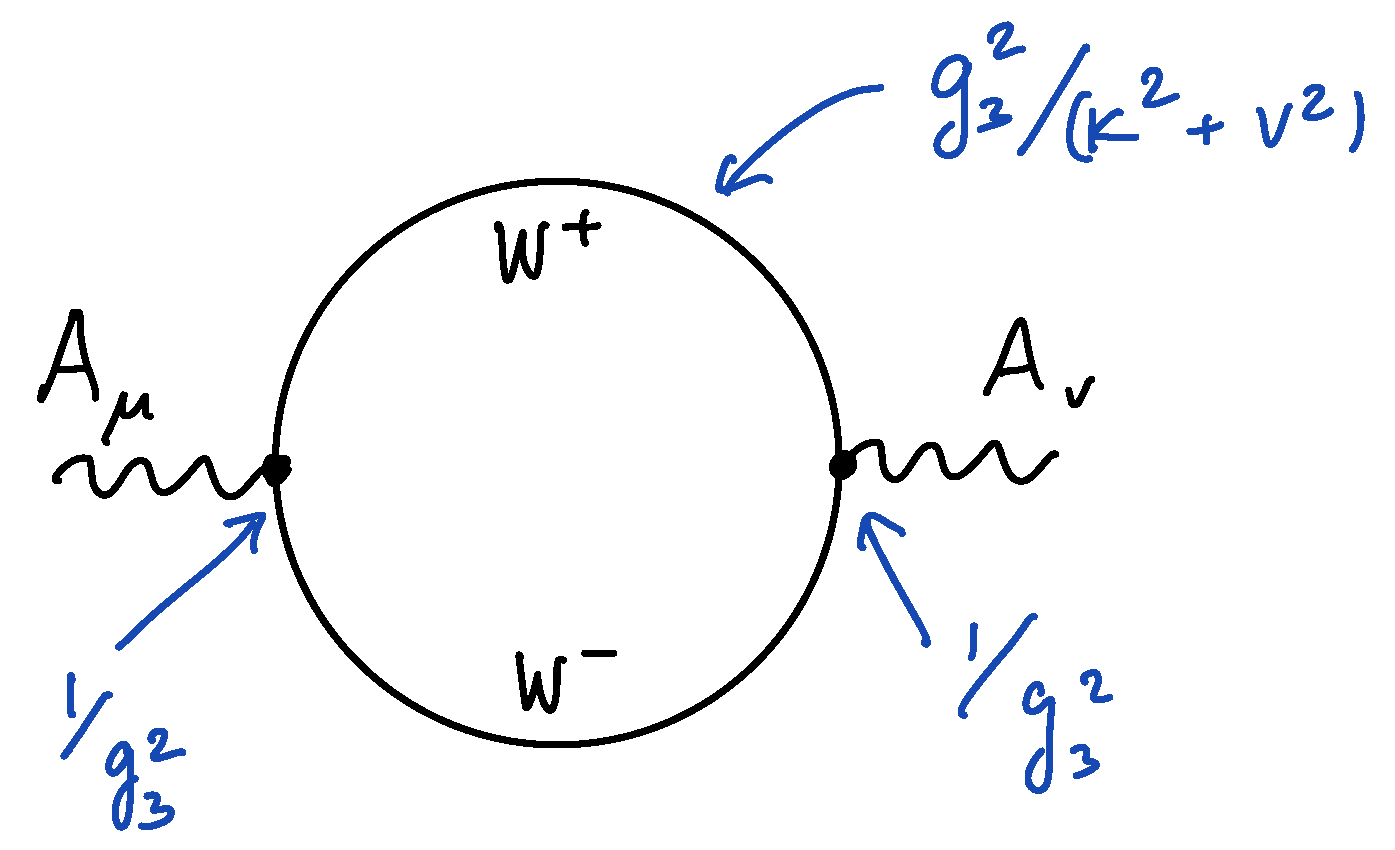
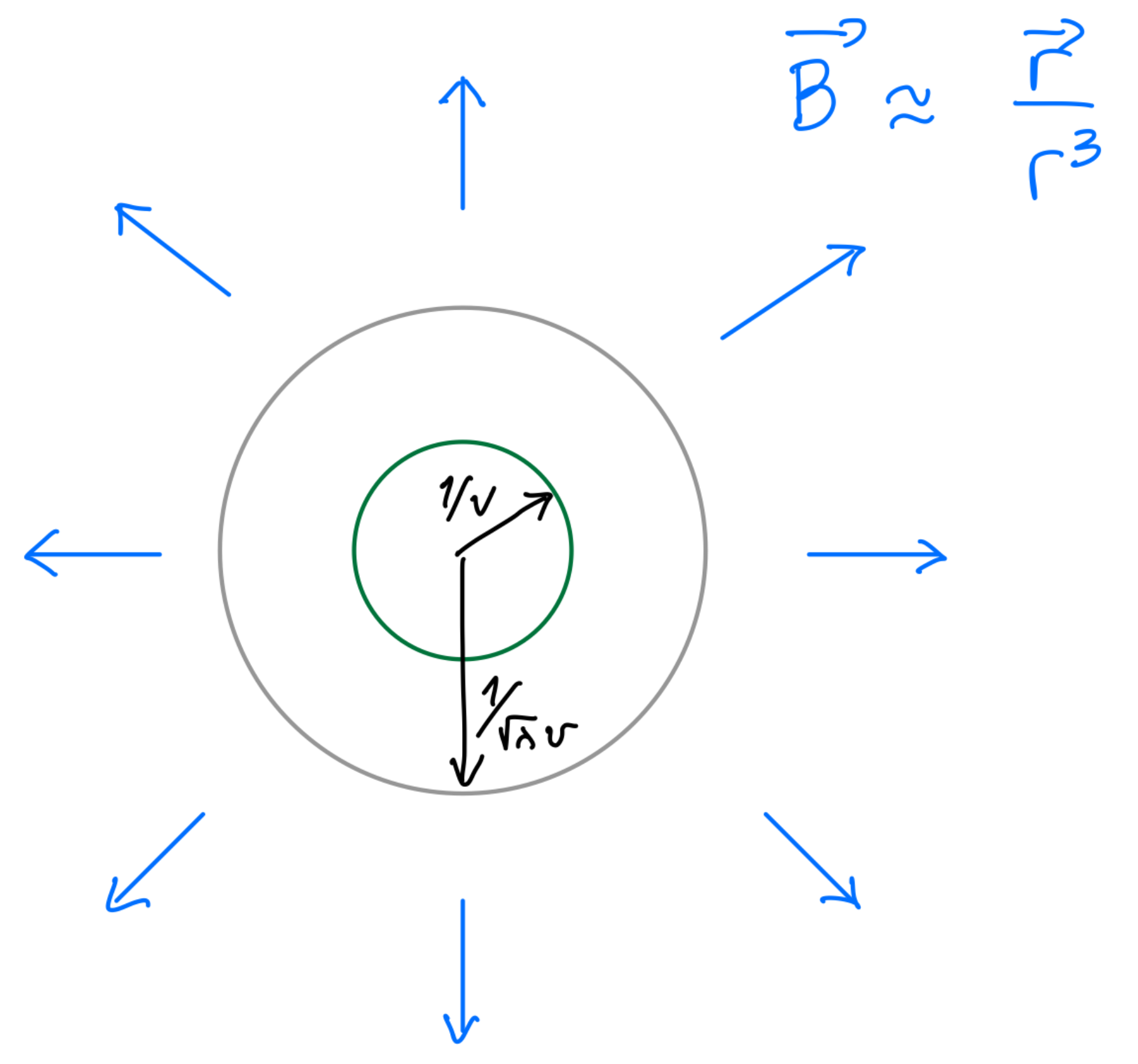
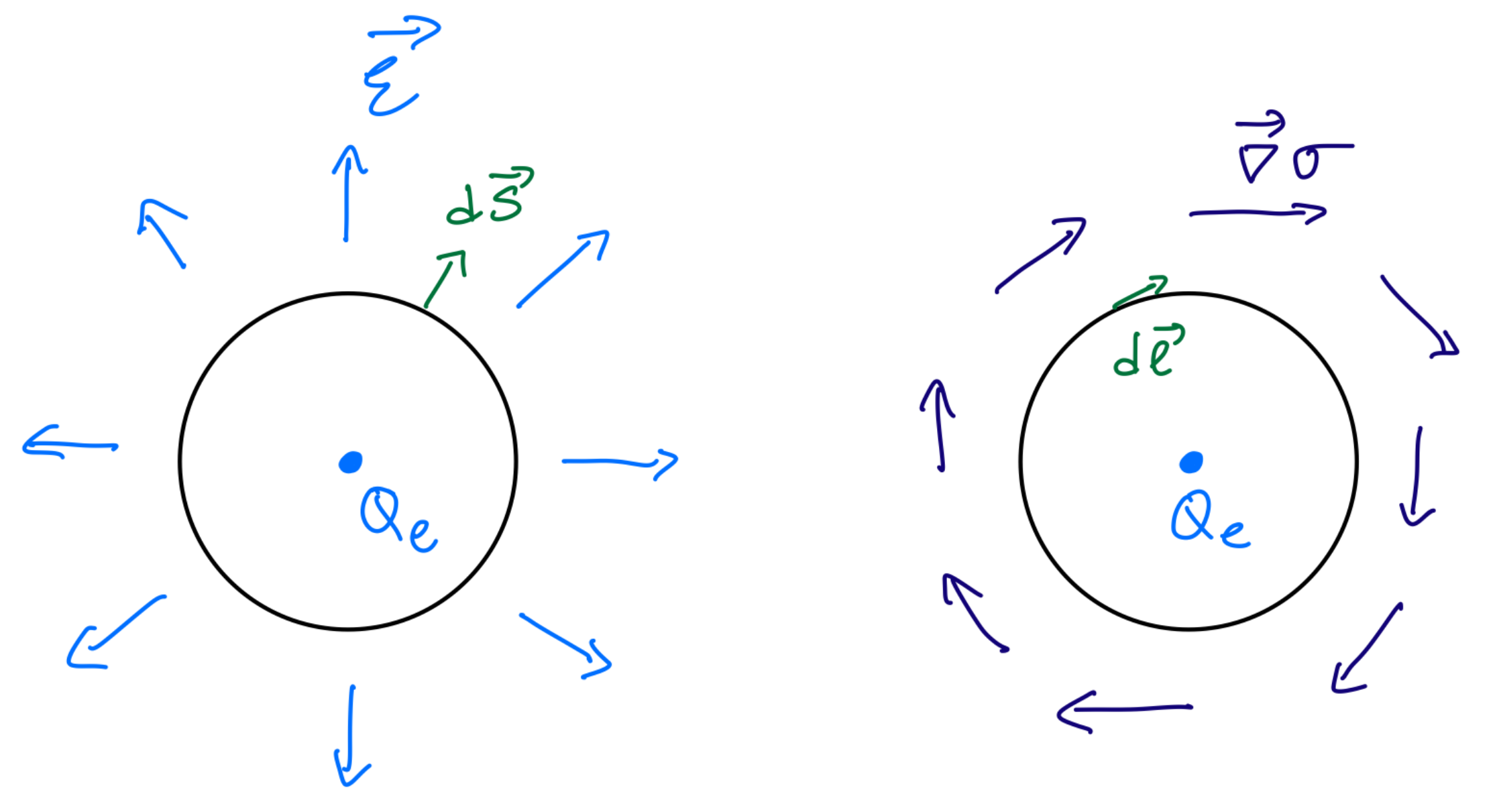
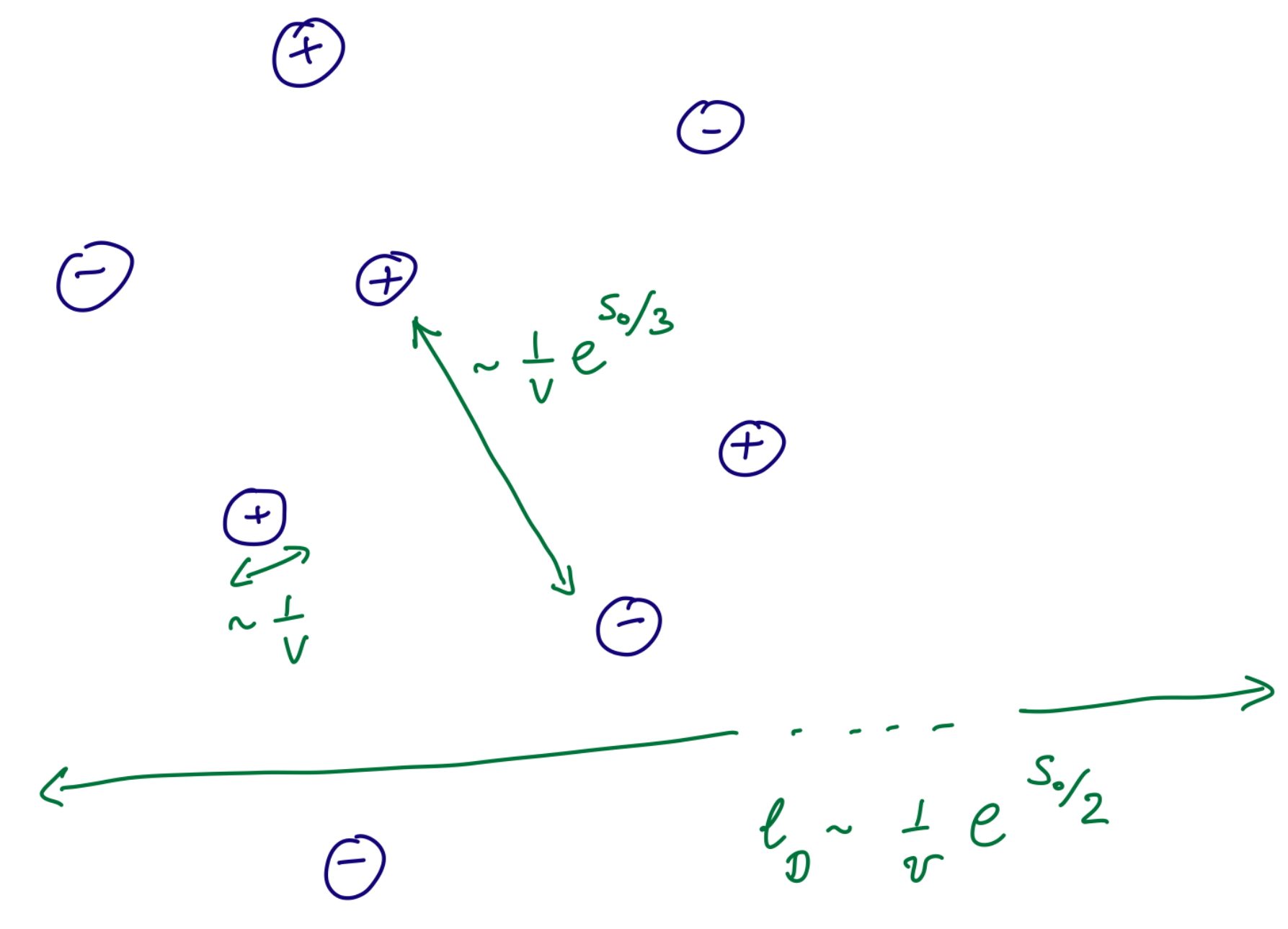
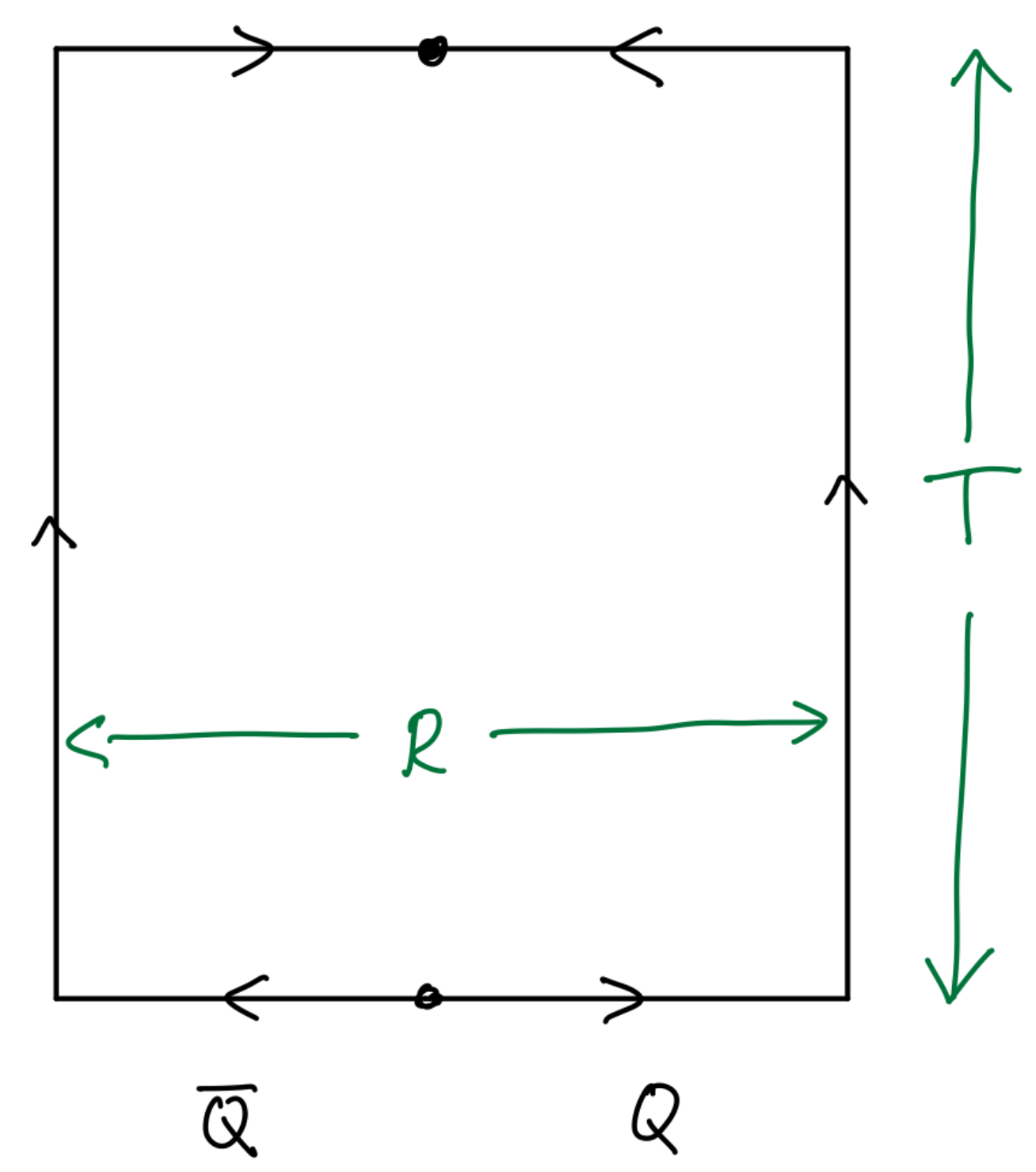
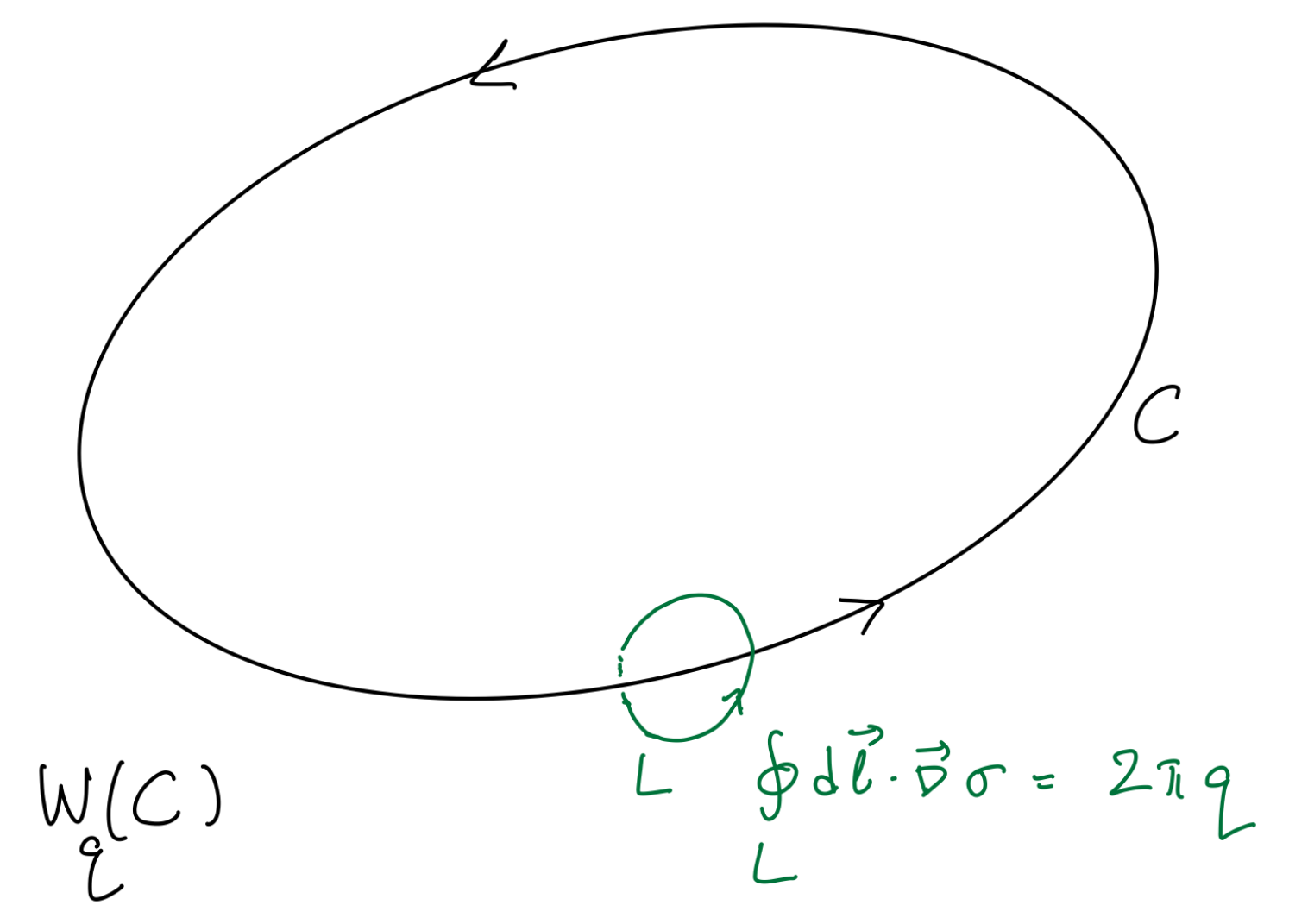
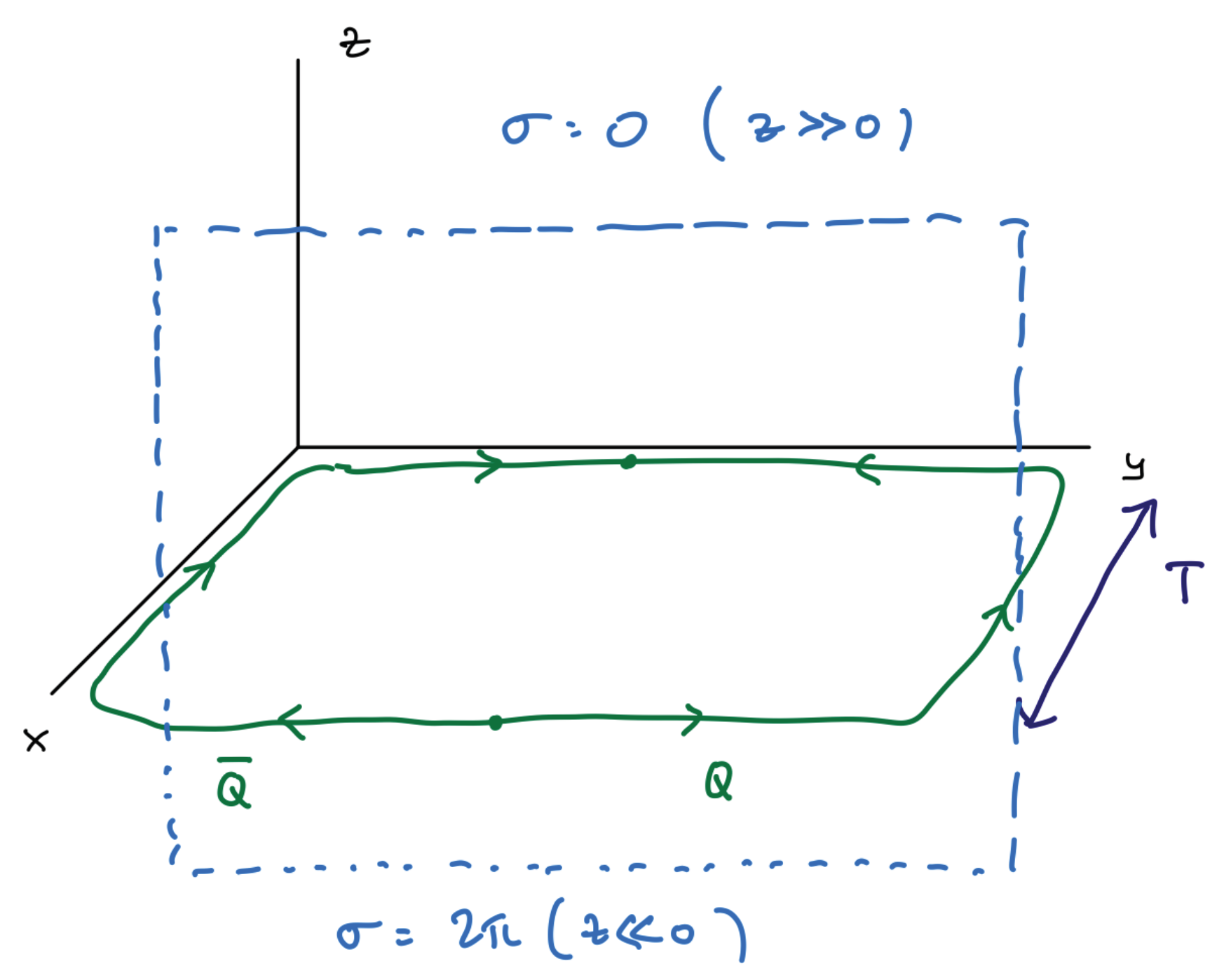
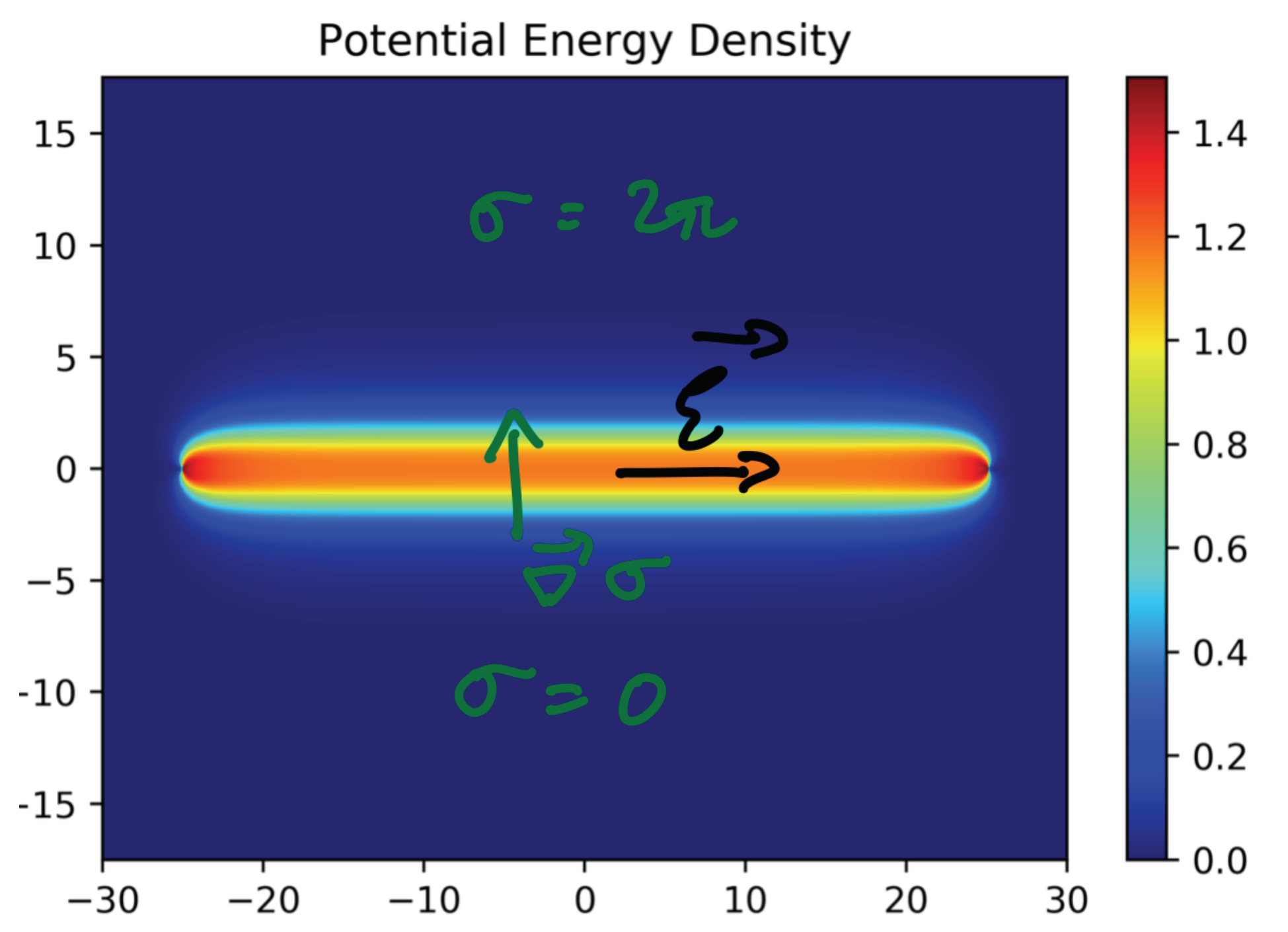
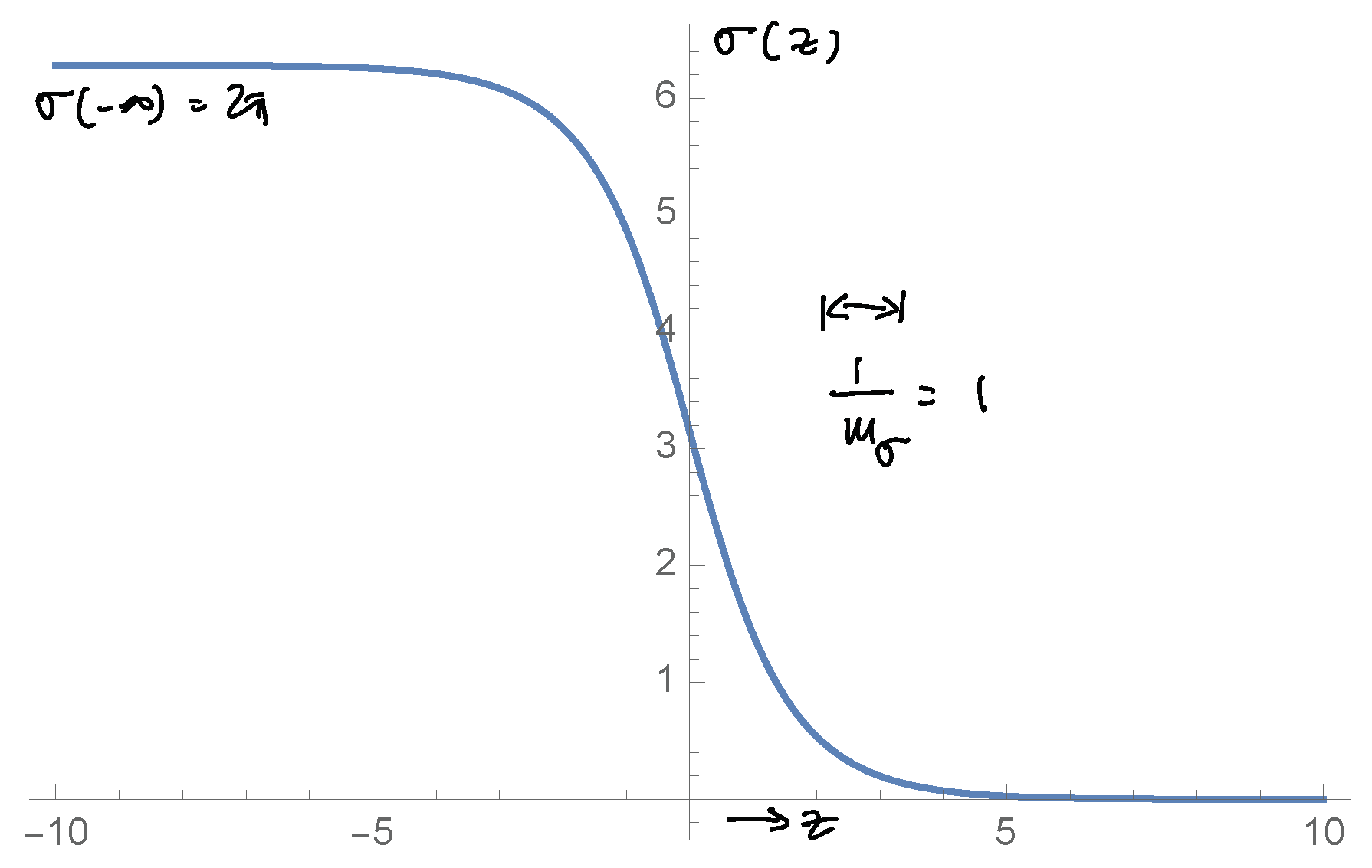
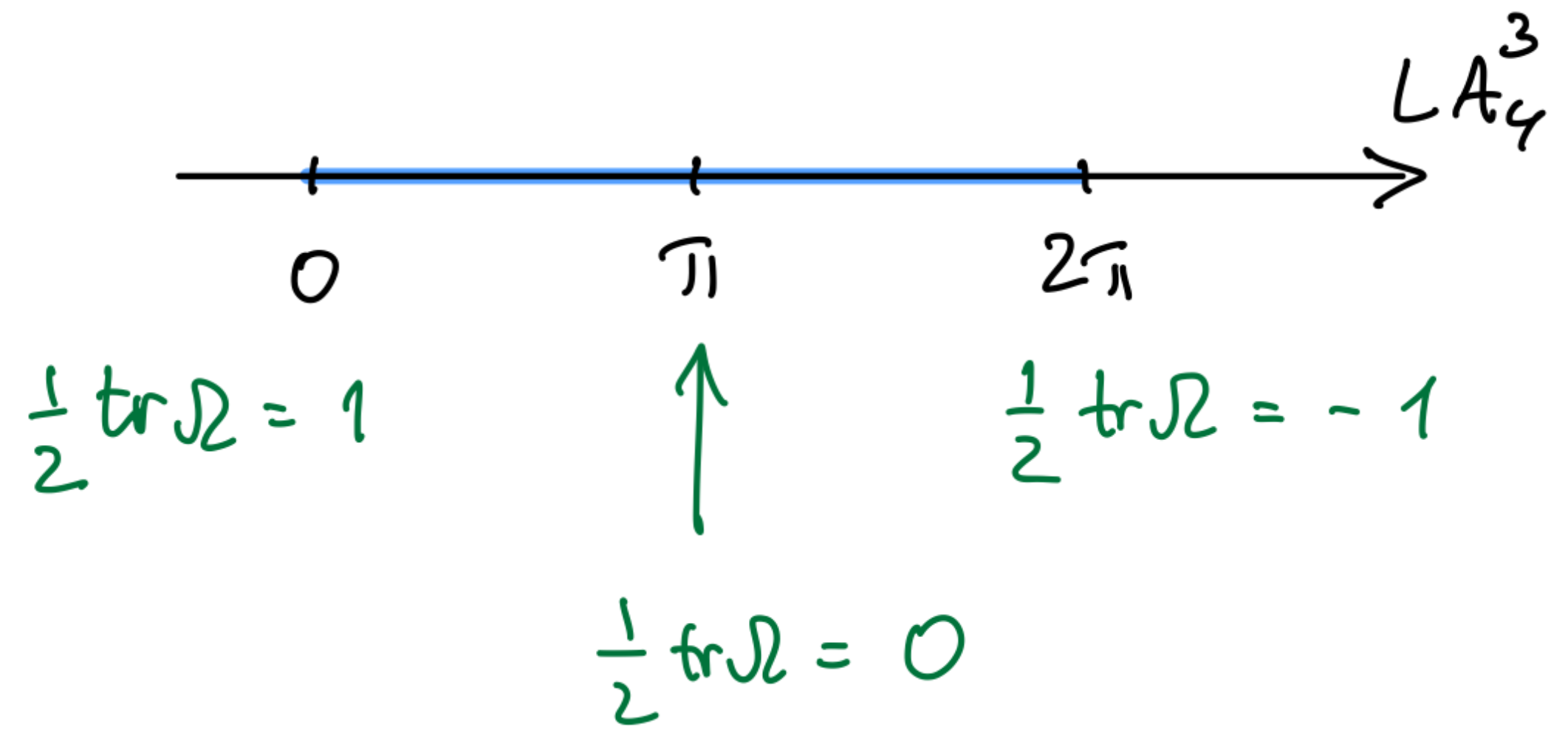
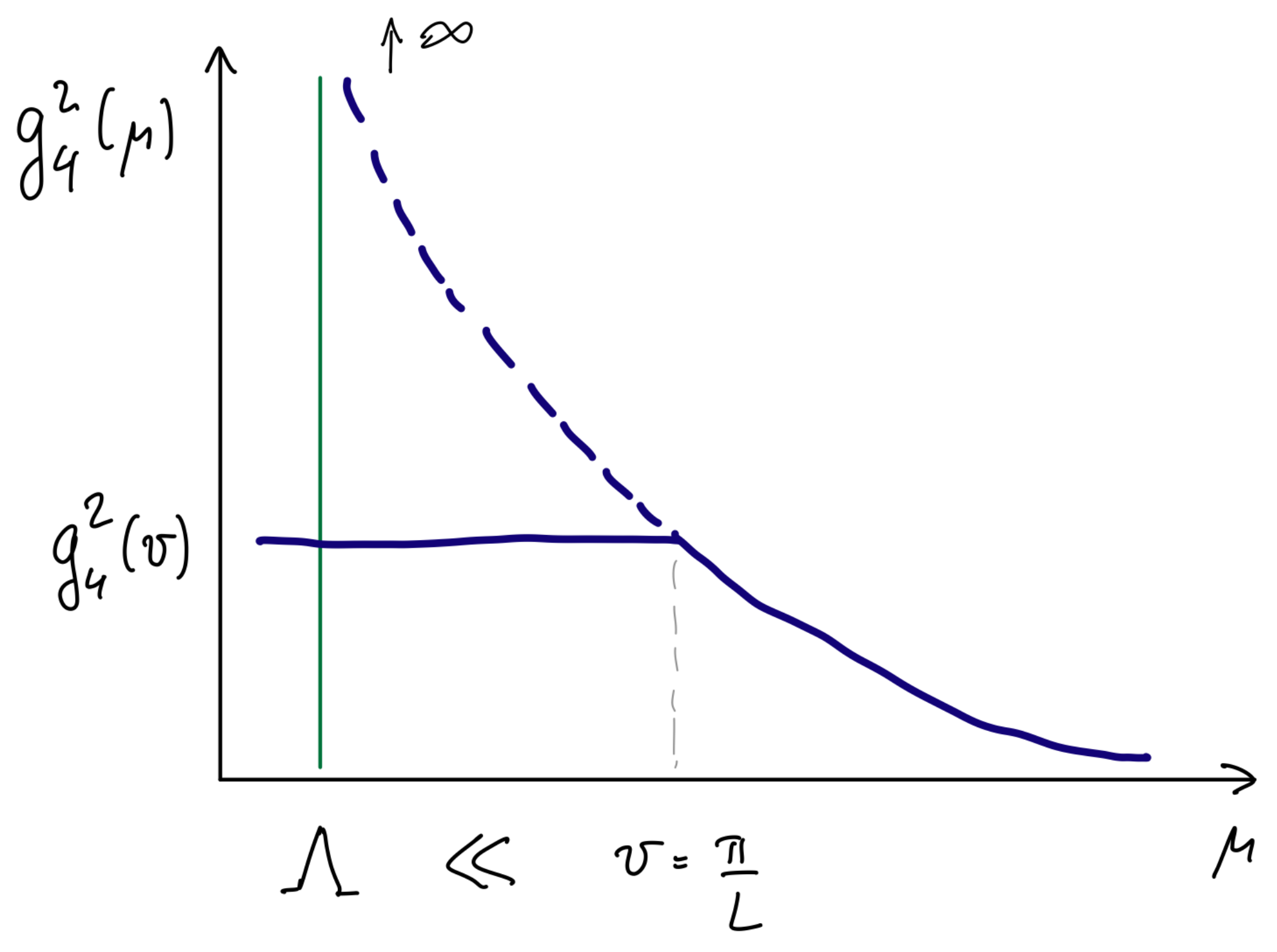
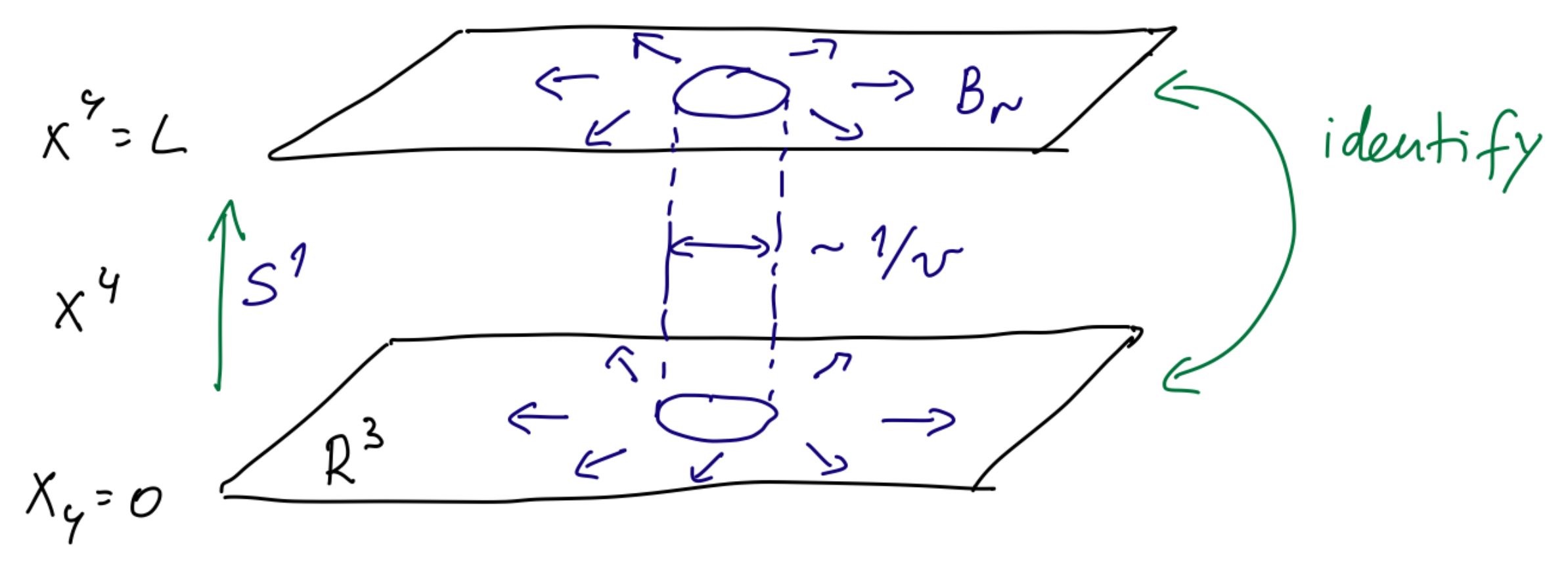


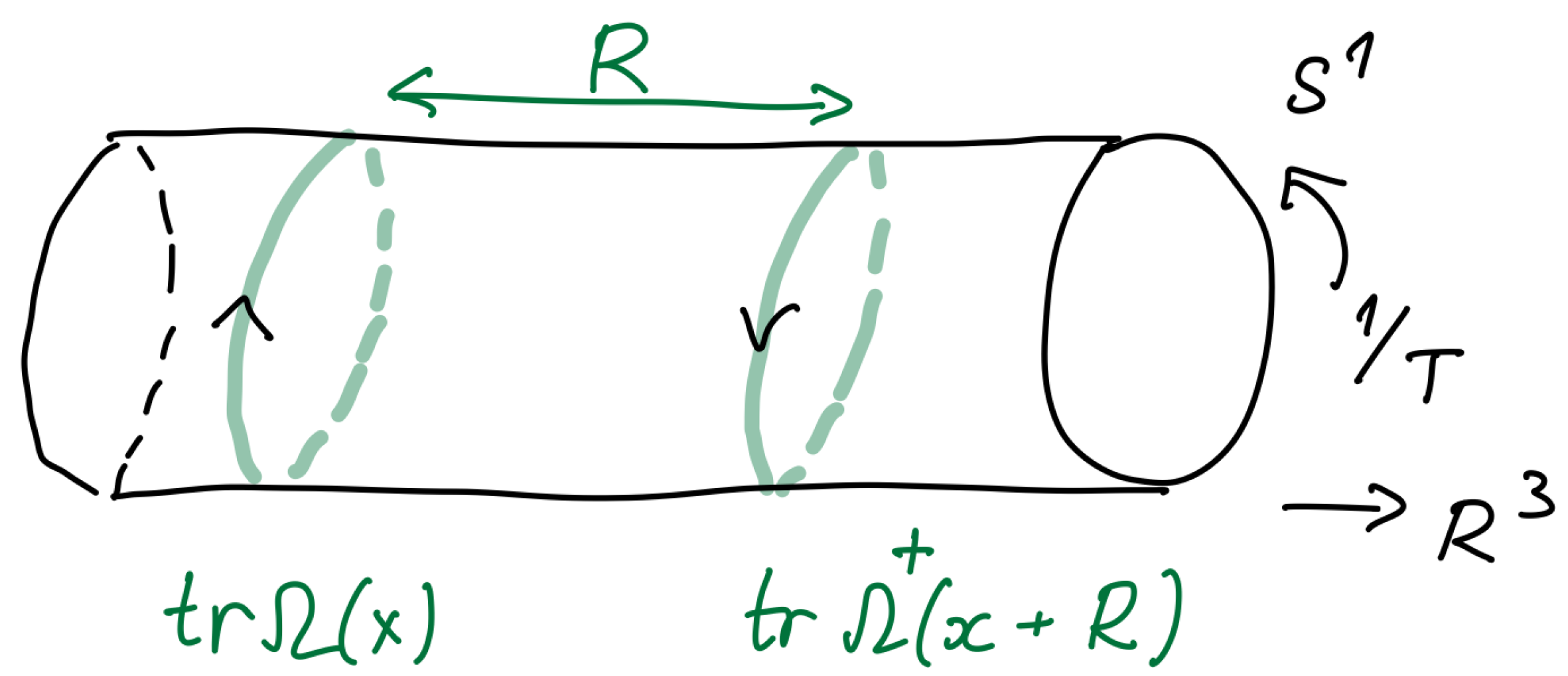
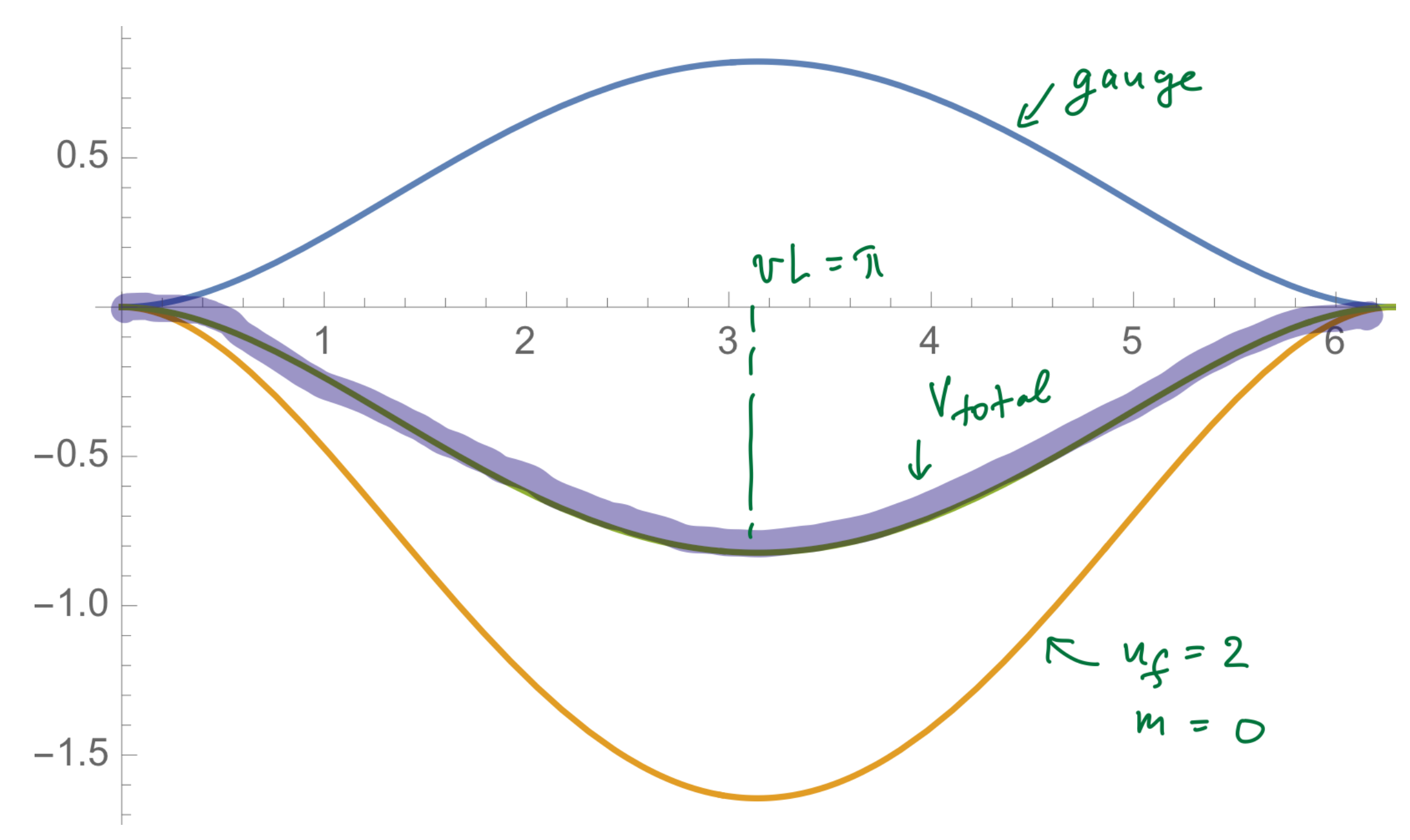
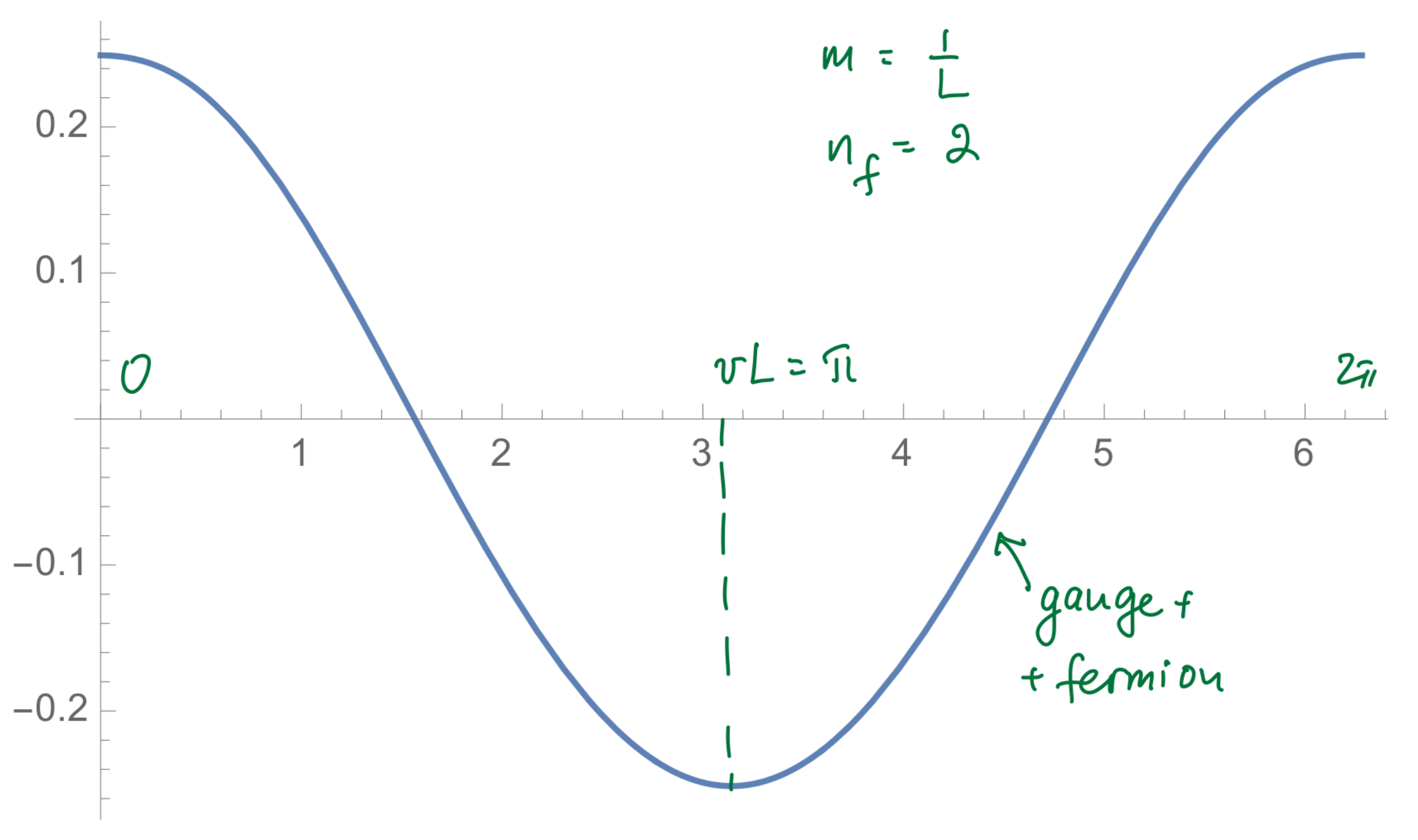
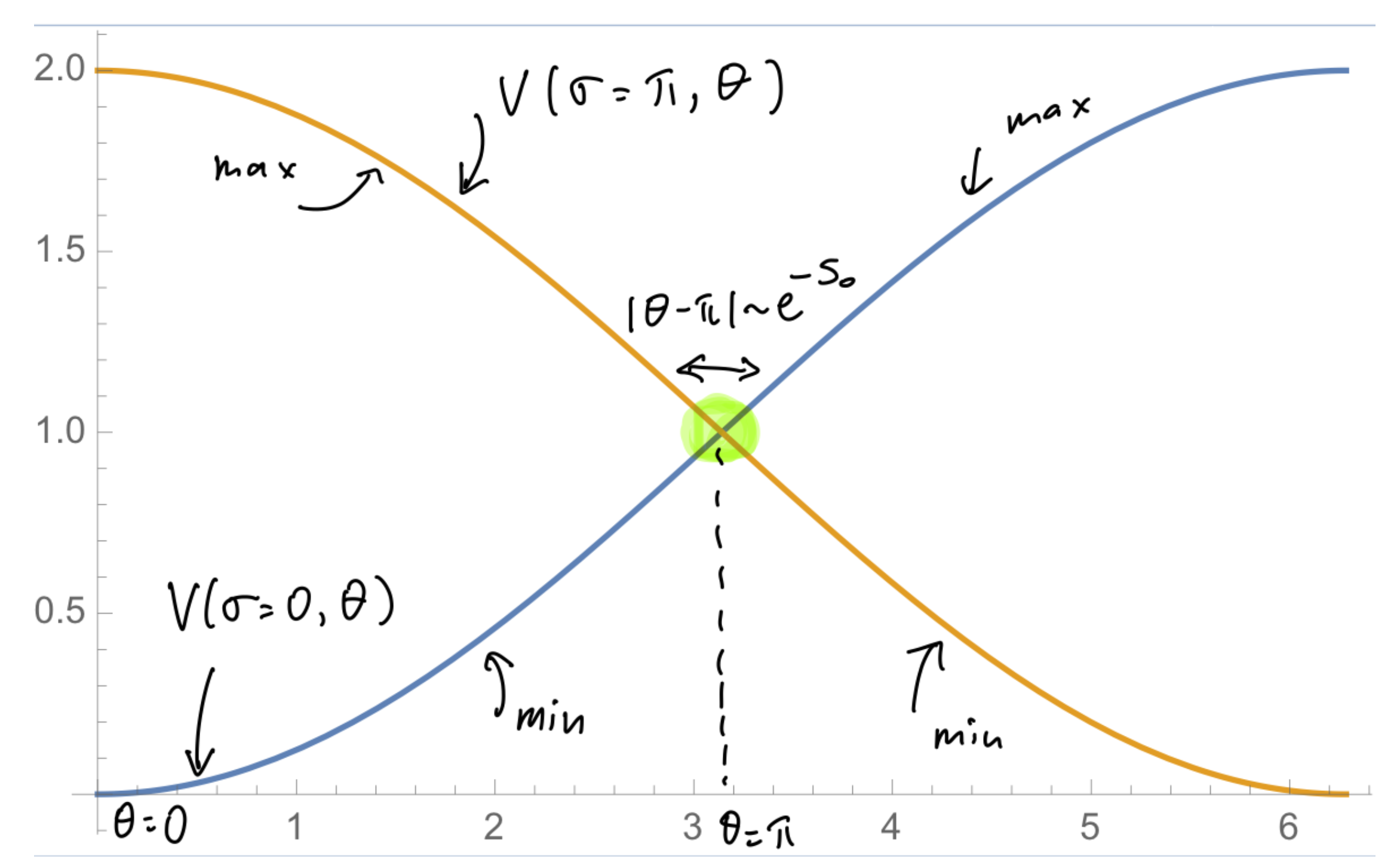
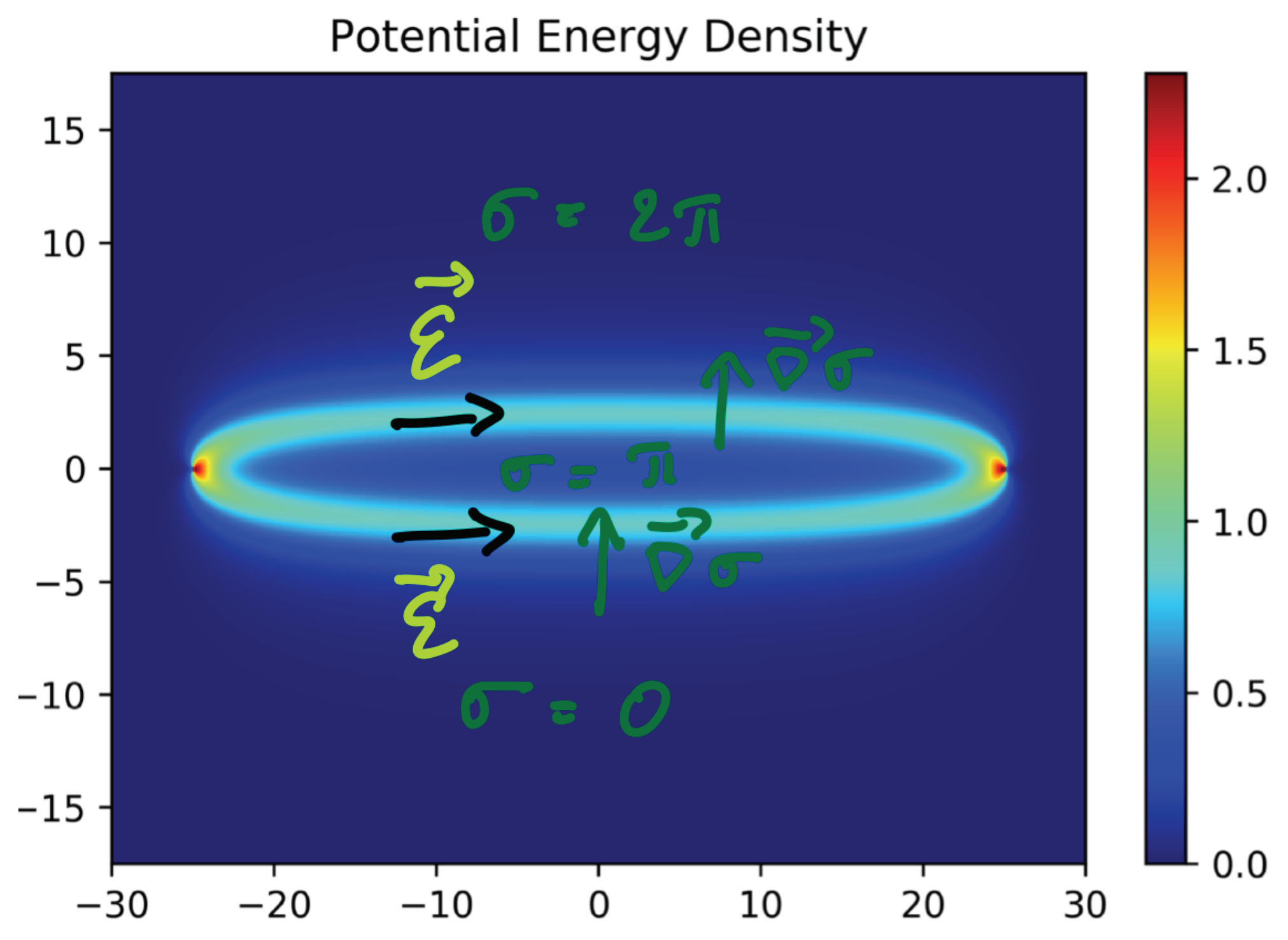
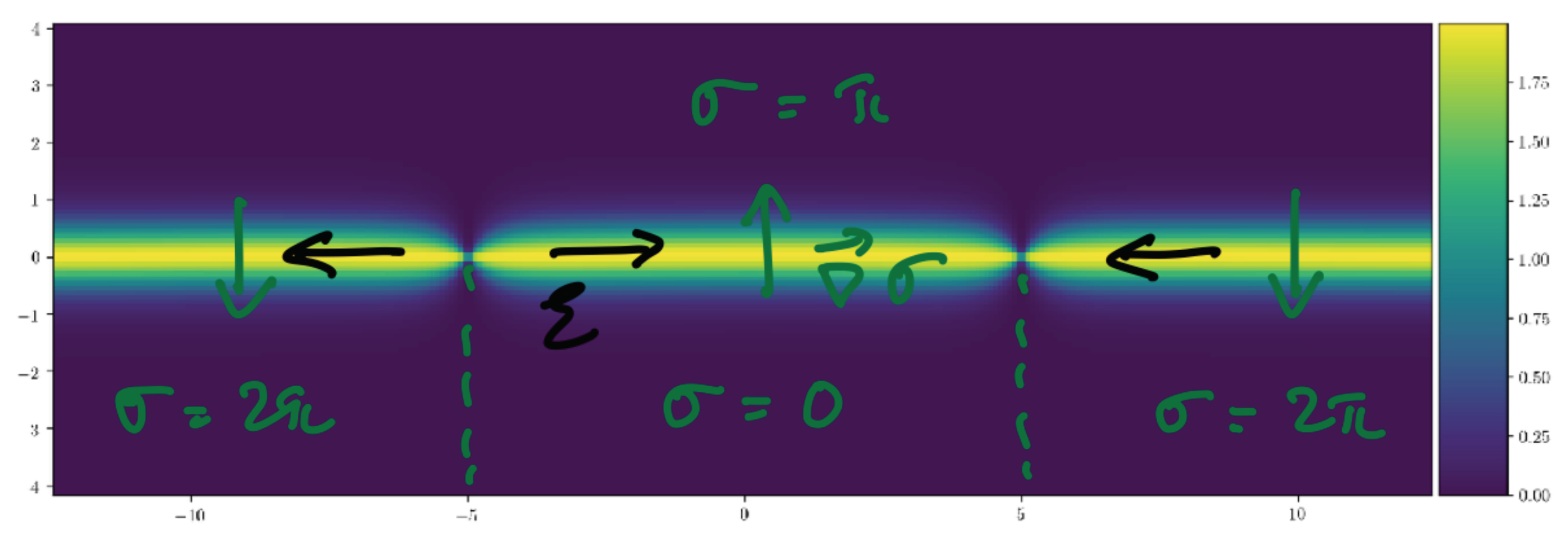
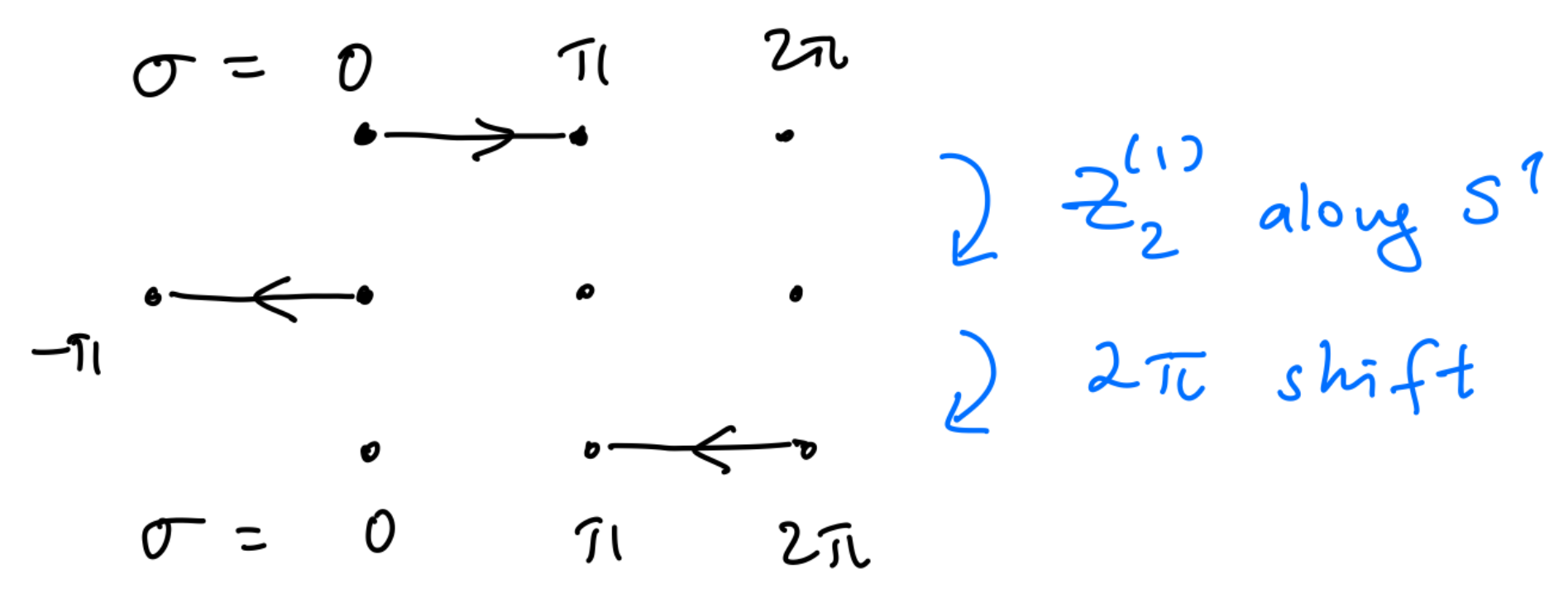

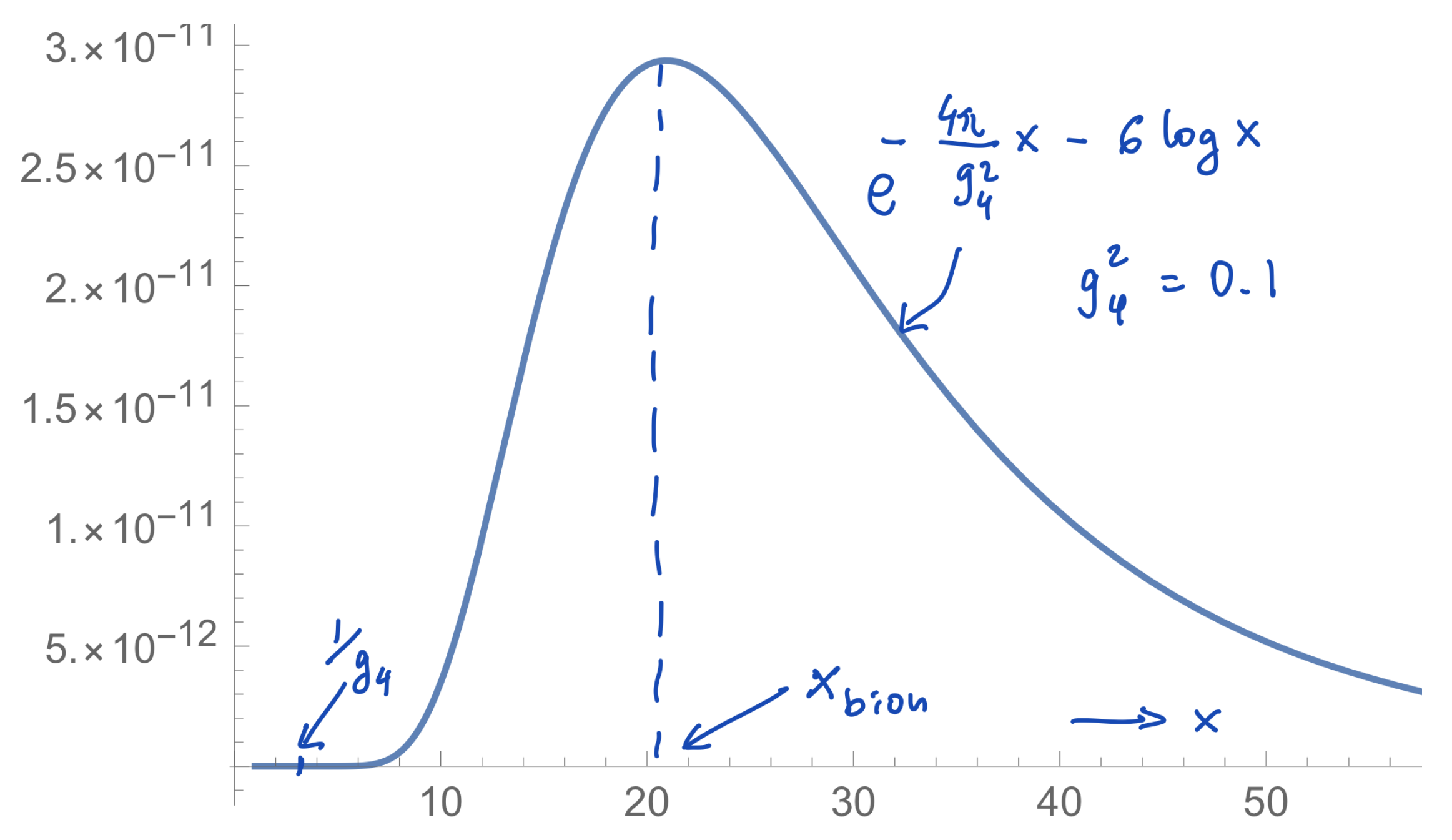
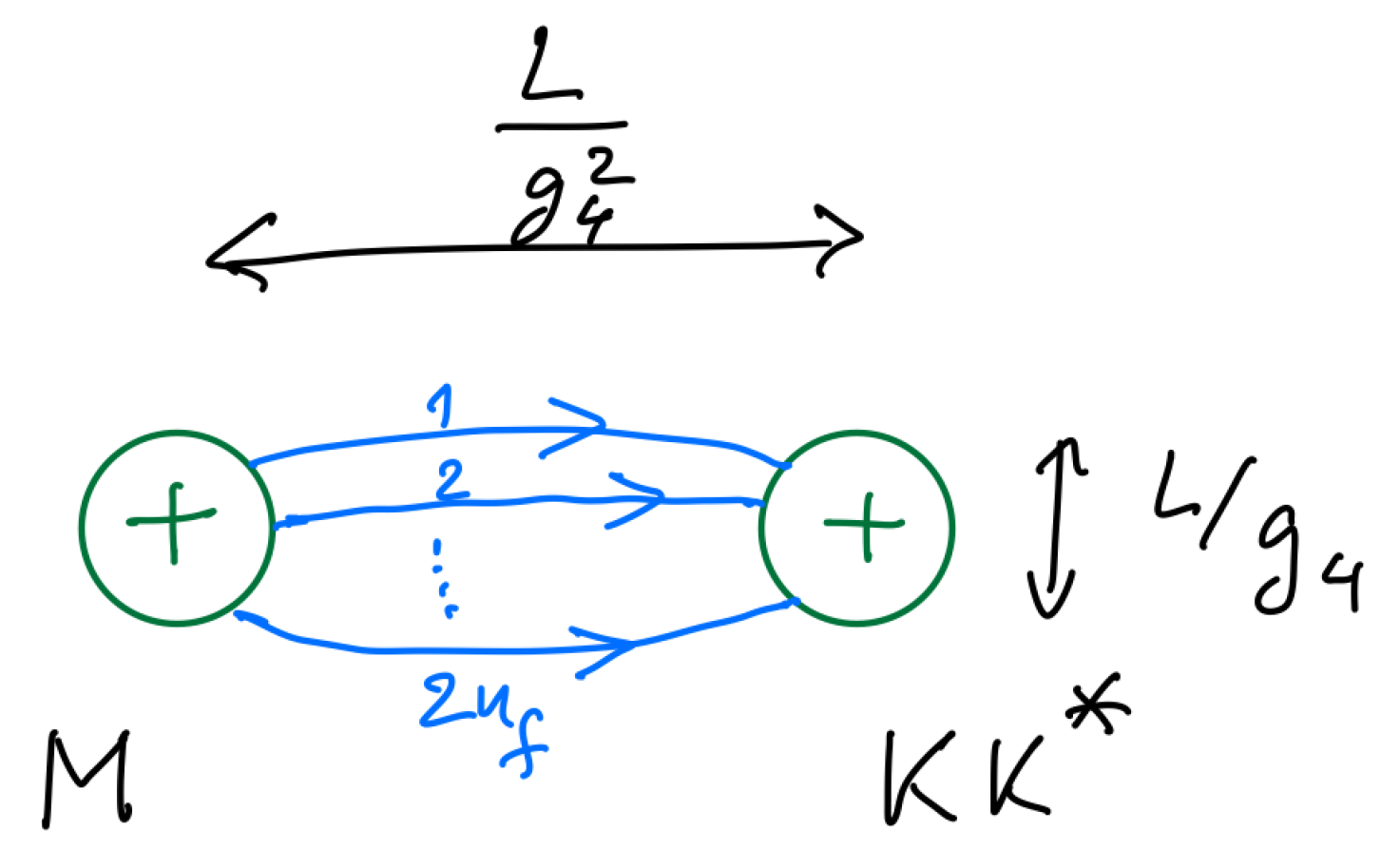
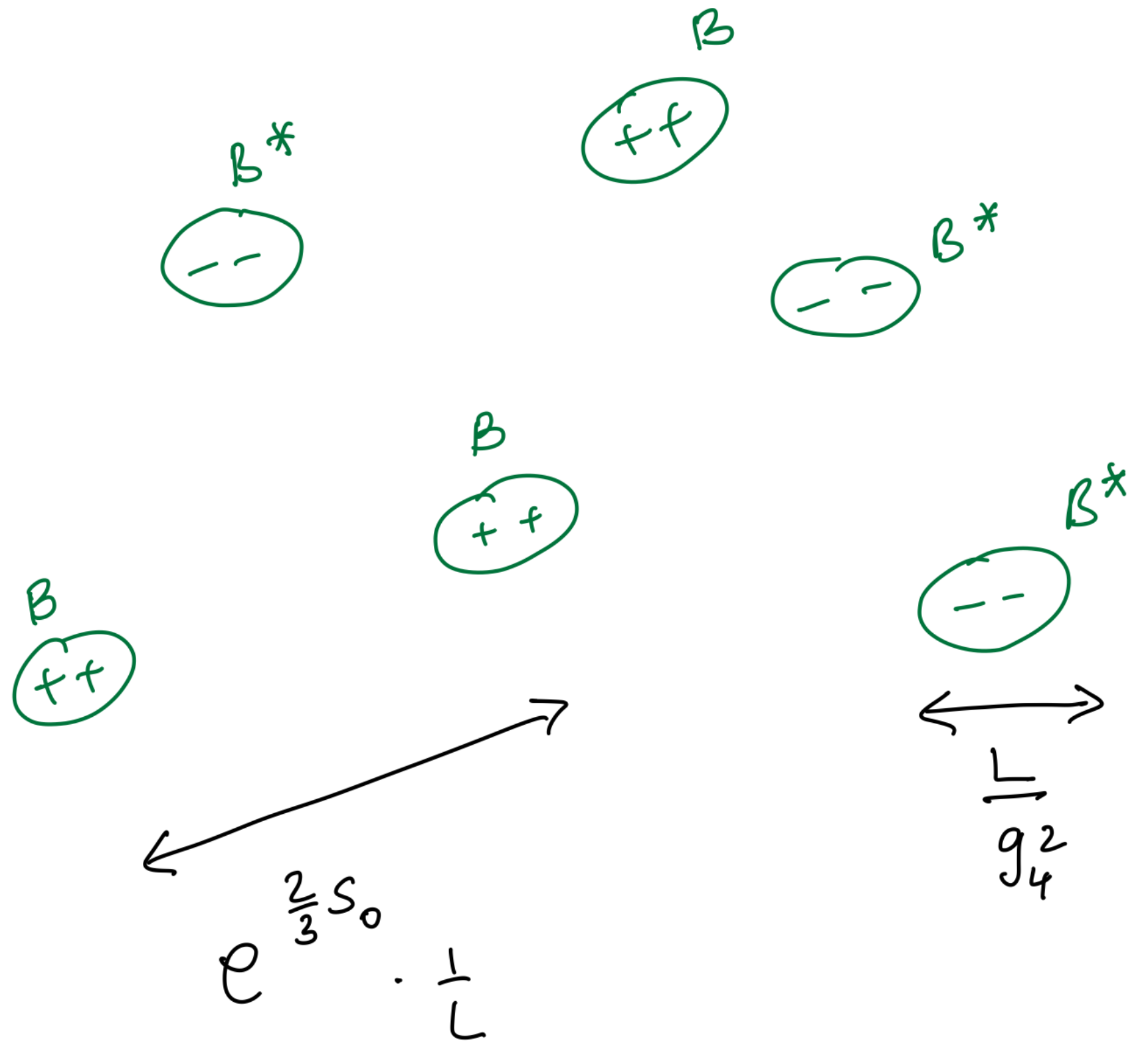
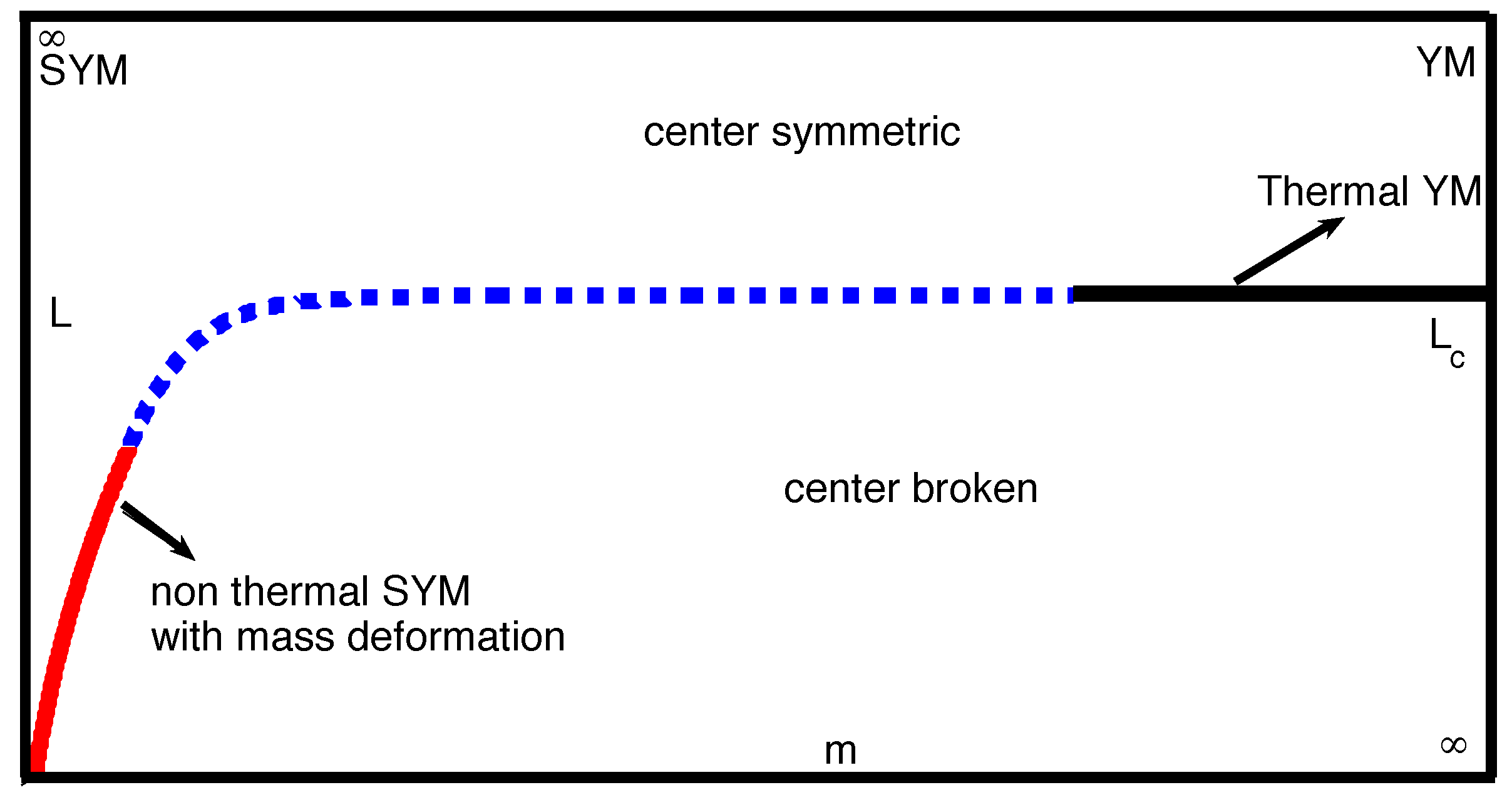
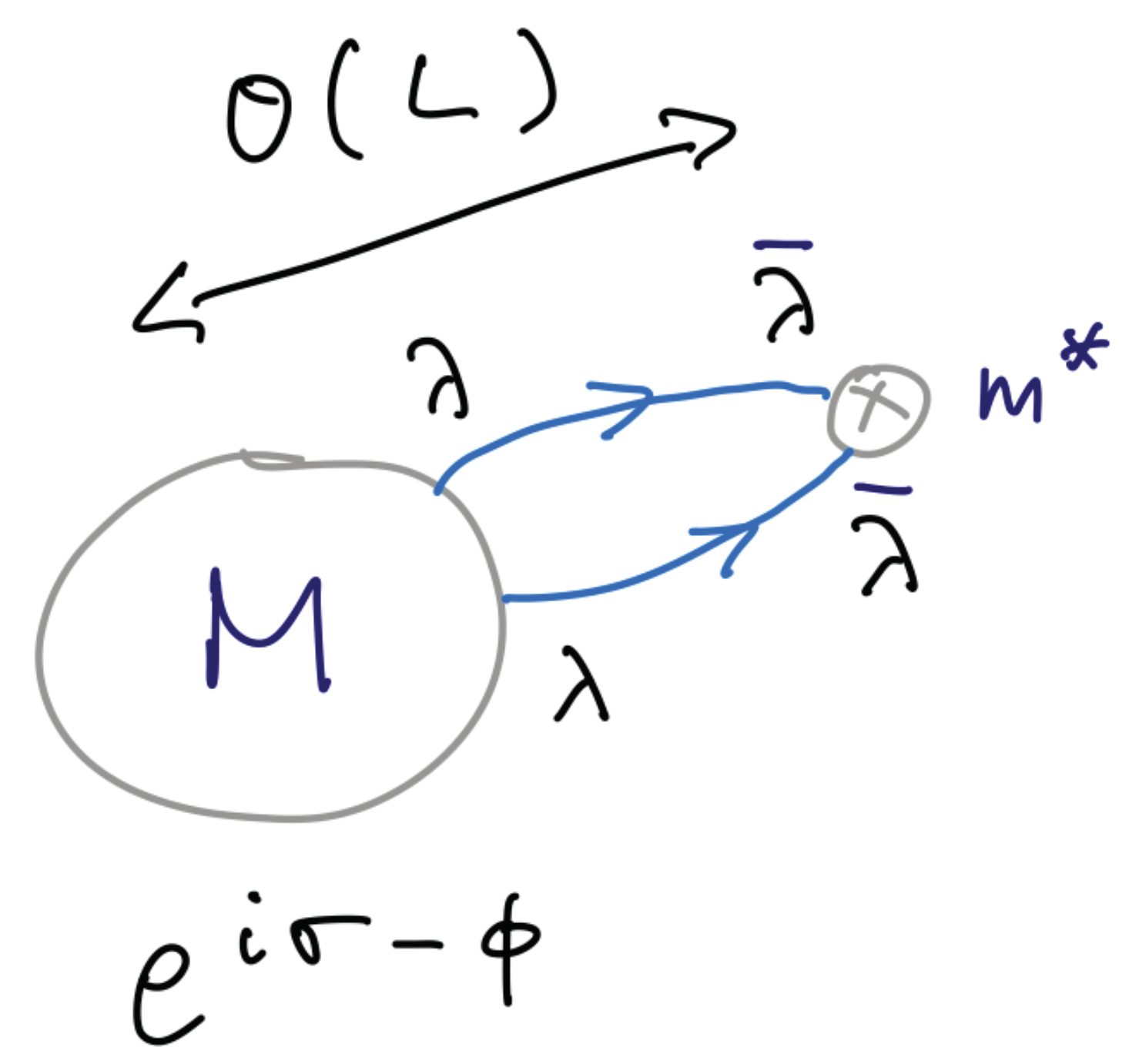
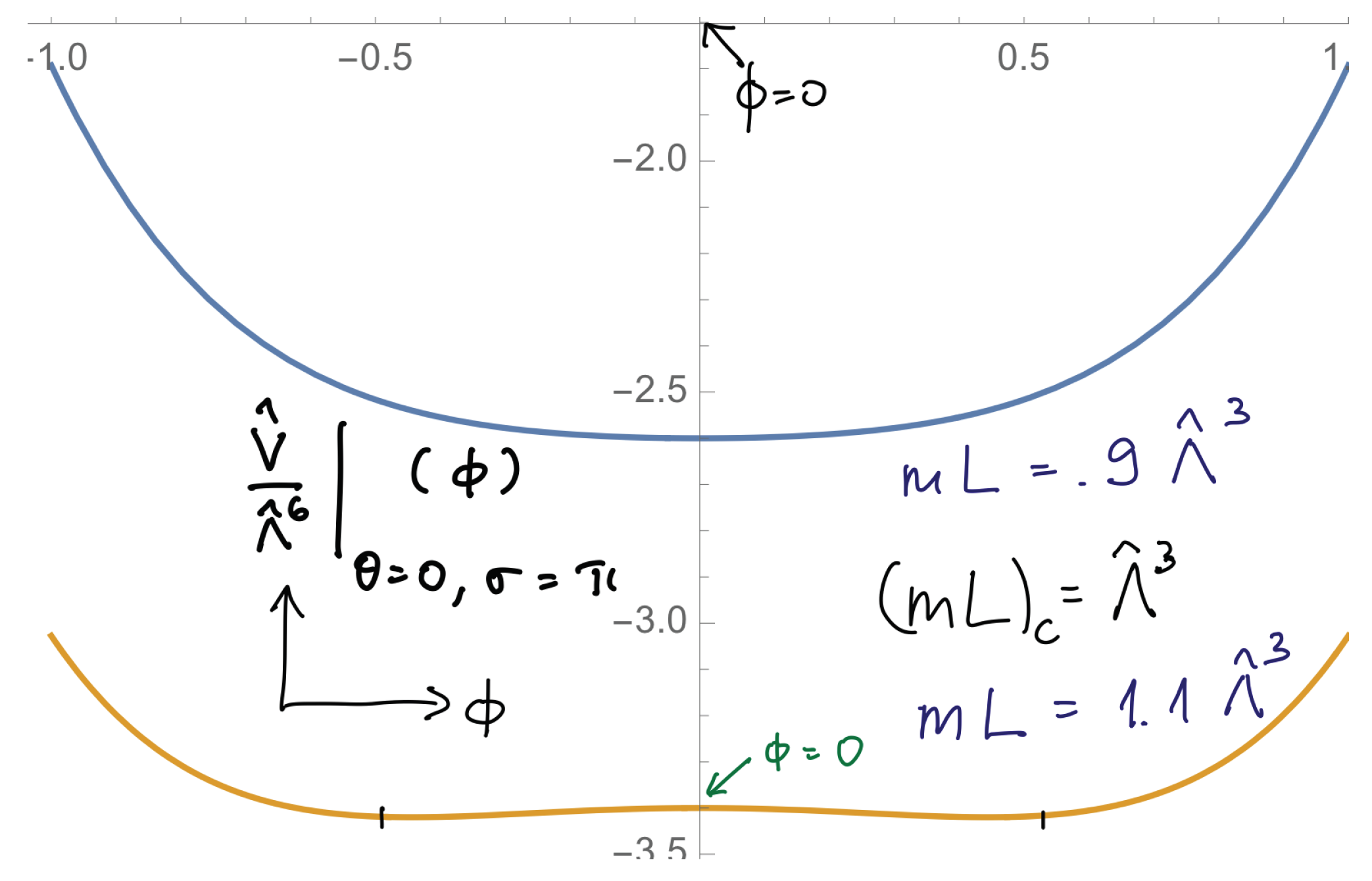
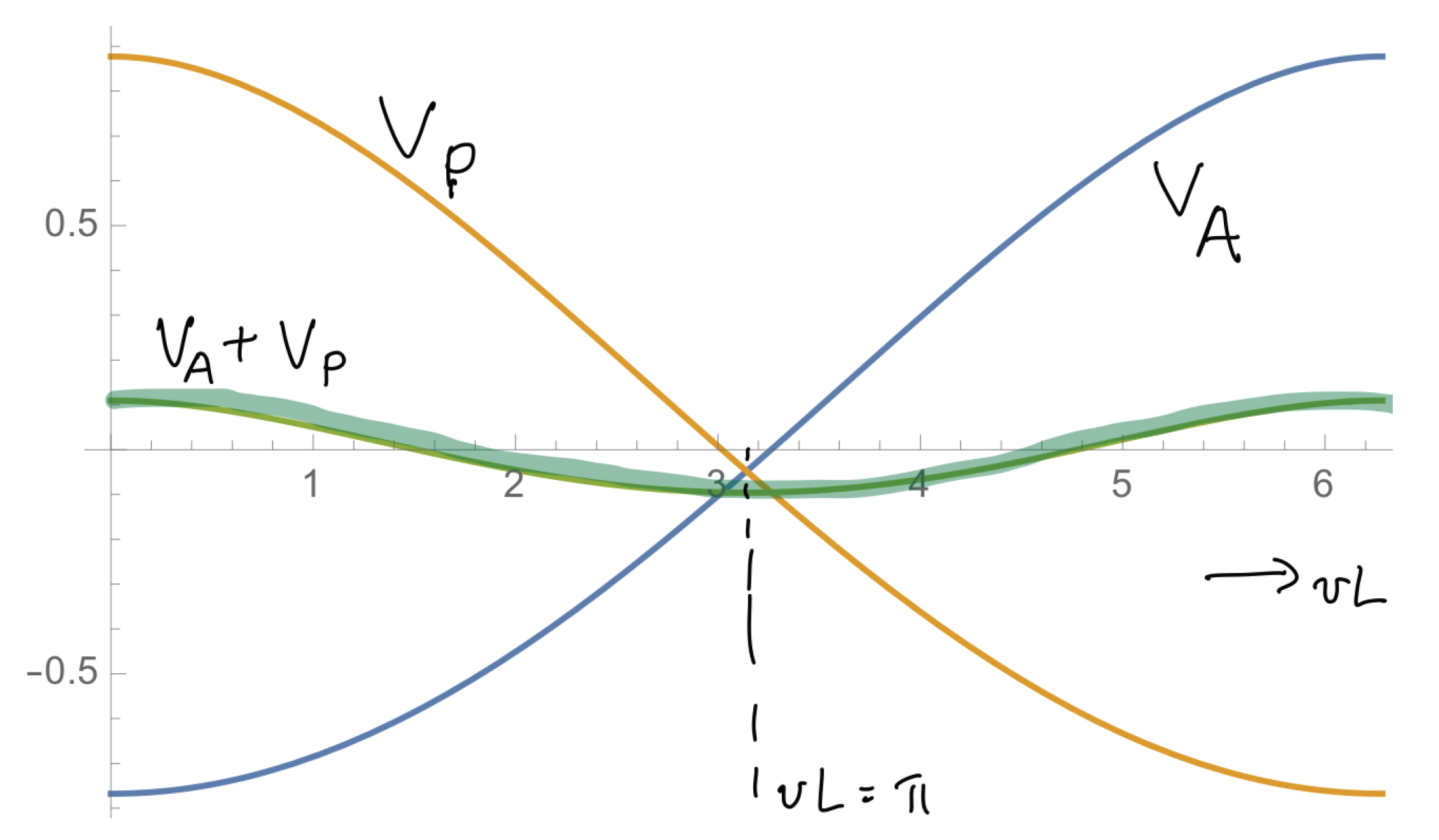
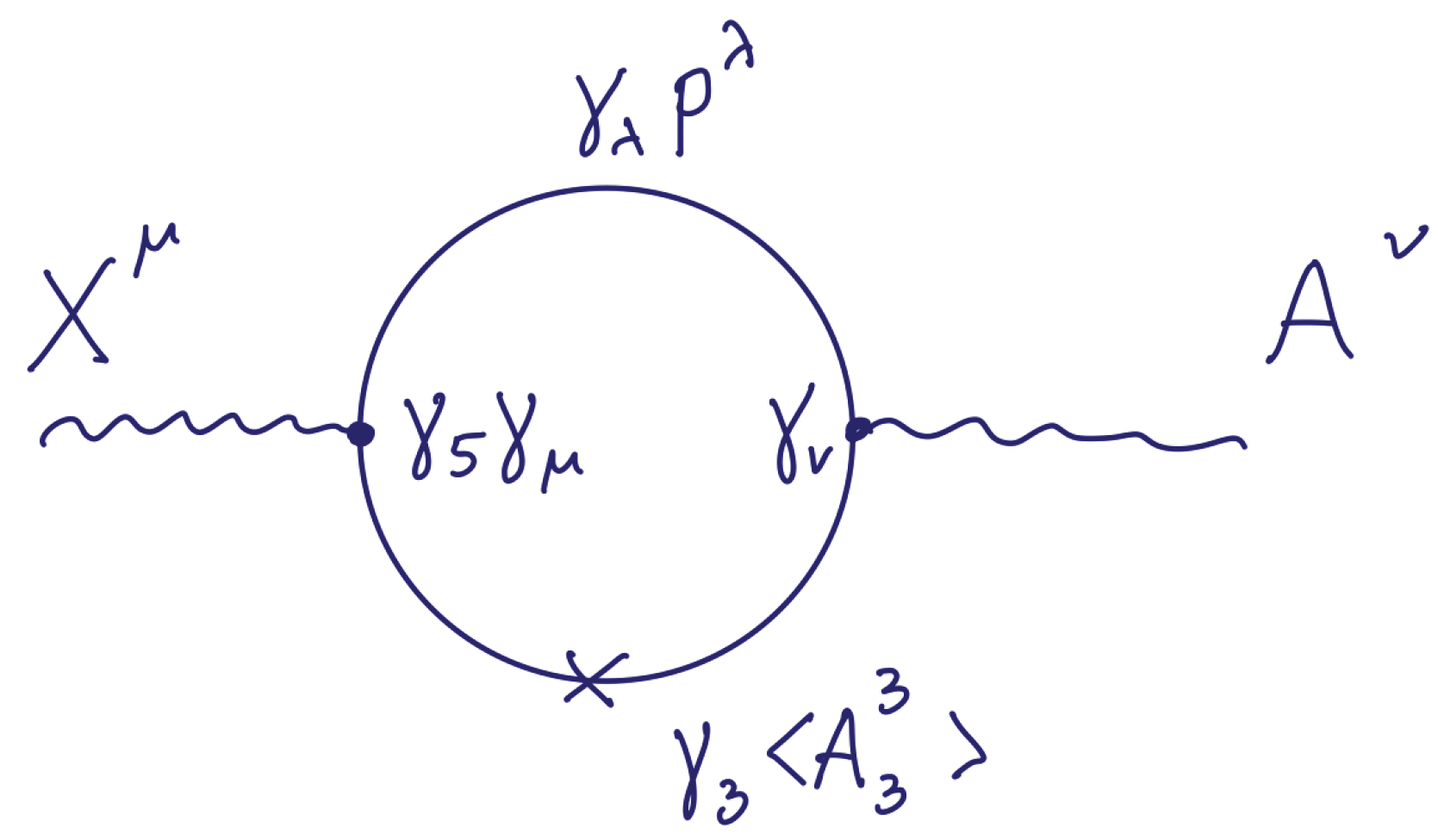
Publisher’s Note: MDPI stays neutral with regard to jurisdictional claims in published maps and institutional affiliations. |
© 2022 by the author. Licensee MDPI, Basel, Switzerland. This article is an open access article distributed under the terms and conditions of the Creative Commons Attribution (CC BY) license (https://creativecommons.org/licenses/by/4.0/).
Share and Cite
Poppitz, E. Notes on Confinement on R3 × S1: From Yang–Mills, Super-Yang–Mills, and QCD (adj) to QCD(F). Symmetry 2022, 14, 180. https://doi.org/10.3390/sym14010180
Poppitz E. Notes on Confinement on R3 × S1: From Yang–Mills, Super-Yang–Mills, and QCD (adj) to QCD(F). Symmetry. 2022; 14(1):180. https://doi.org/10.3390/sym14010180
Chicago/Turabian StylePoppitz, Erich. 2022. "Notes on Confinement on R3 × S1: From Yang–Mills, Super-Yang–Mills, and QCD (adj) to QCD(F)" Symmetry 14, no. 1: 180. https://doi.org/10.3390/sym14010180
APA StylePoppitz, E. (2022). Notes on Confinement on R3 × S1: From Yang–Mills, Super-Yang–Mills, and QCD (adj) to QCD(F). Symmetry, 14(1), 180. https://doi.org/10.3390/sym14010180




